The Pacific Northwest
Please accept my apologies for the long time gap since my last blog post. In August of 2021, I made the decision to move back to New Jersey because the U.S./Canada border remained closed due to COVID-19, making it impossible for me to achieve my final goal of visiting Alaska. I had no idea when the border would reopen and had been bouncing around the western U.S. for two years so I returned home to re-settle into a stationary lifestyle. I have since bought a house at the Jersey Shore but I’m planning one final adventure to Alaska in 2023 so stay tuned!
TWIN FALLS, IDAHO – June 3-10, 2021
TWIN FALLS
On June 3, I moved north from Ely, Nevada to Twin Falls in southern Idaho, and spent a week exploring the numerous (more than two that are implied by the name “Twin Falls”) waterfalls in the area. I stayed nearby at Anderson Camp RV Park. This part of Idaho was reminiscent of Arizona with its rocky plateaus and deep river canyons.
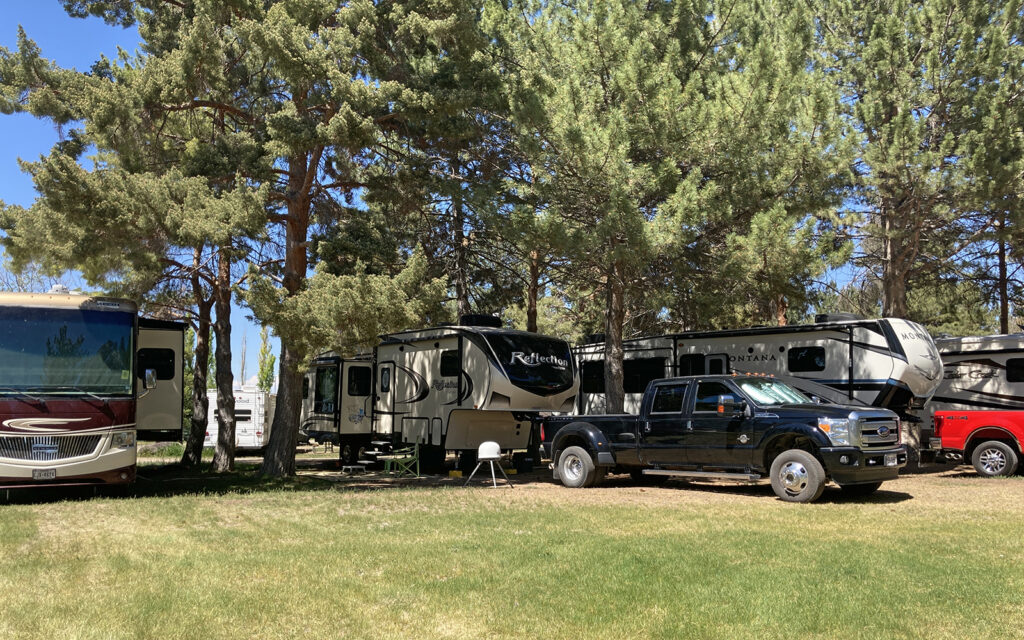
My campsite at Anderson Camp RV Park in Eden, Idaho.
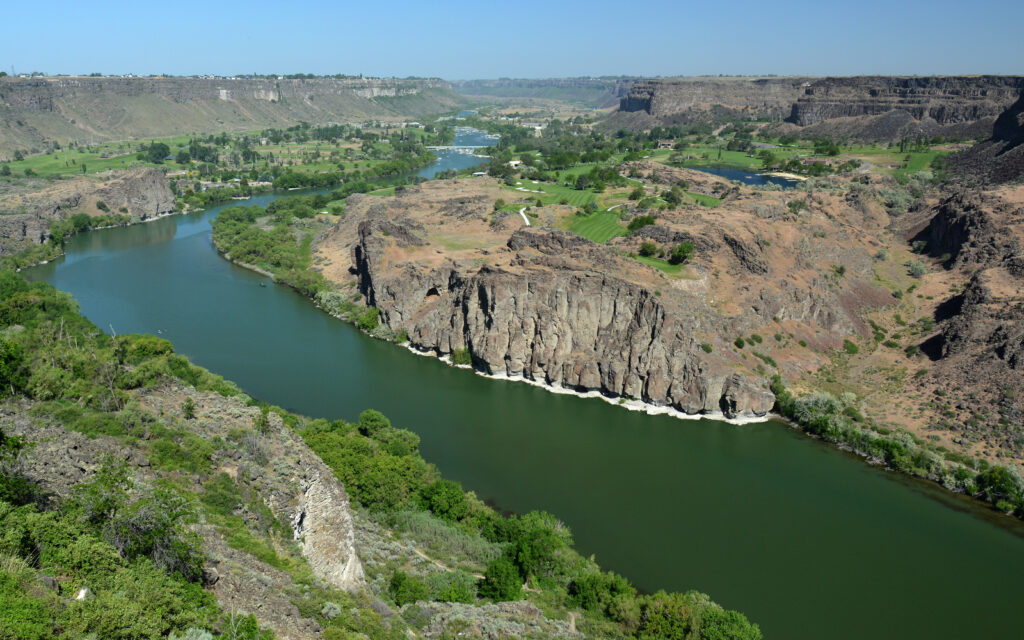
The Snake River “snakes” its way through Twin Falls, Idaho.
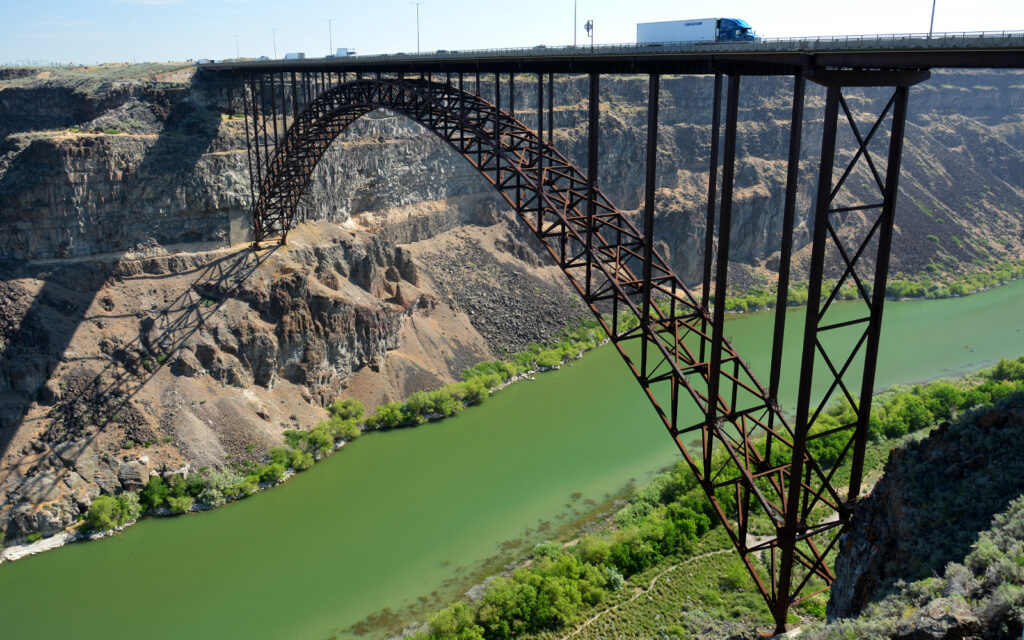
The 1,500-foot-long Perrine Bridge spans the canyon 486 feet above the Snake River and is a popular location for base jumpers.
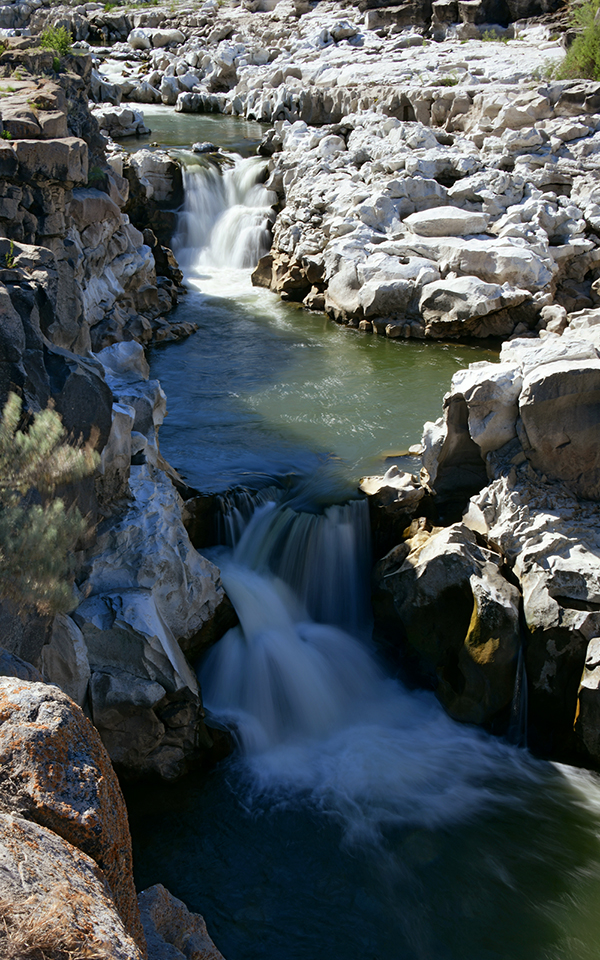
Cauldron Linn Falls is located 25 miles east of Twin Falls, Idaho.
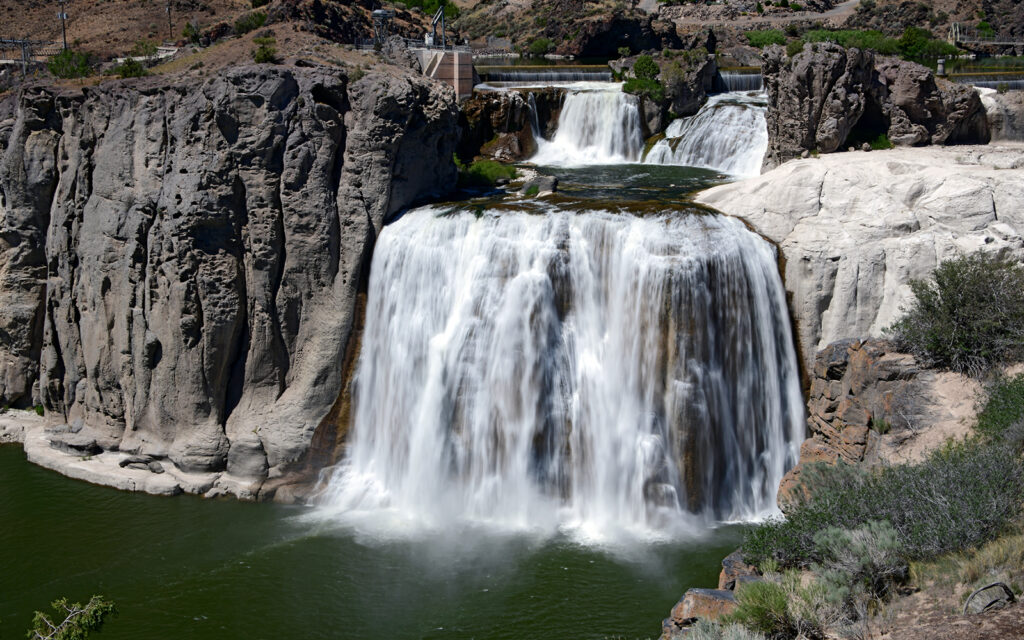
Shoshone Falls lies just on the eastern edge of the town of Twin Falls, Idaho.
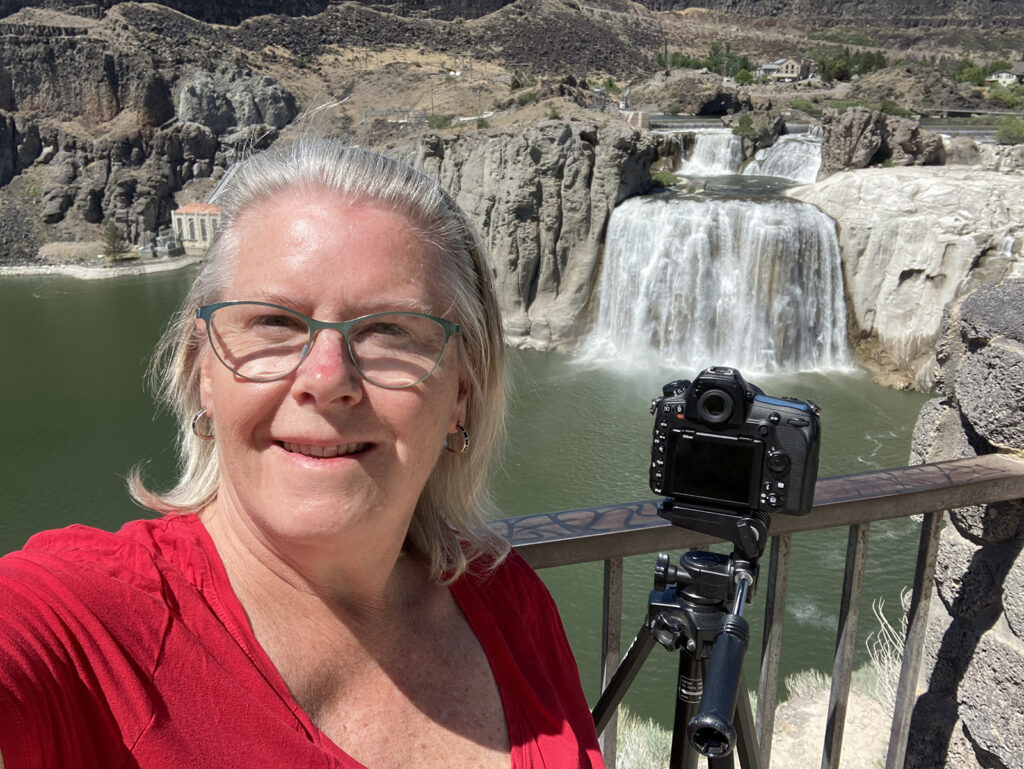
I’m happiest when photographing pretty landscapes… and unhappy with long hair. Ugh!
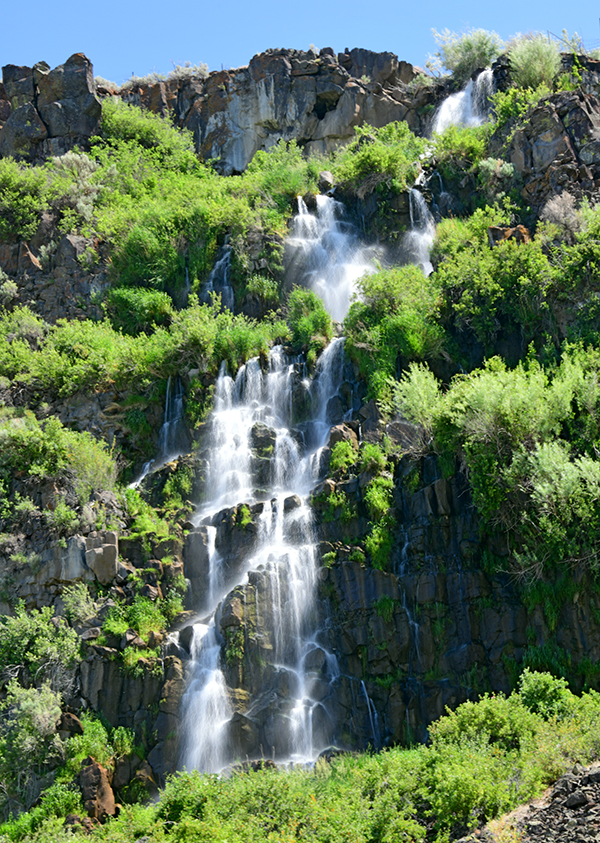
This unnamed waterfall cascades down the canyon wall from downtown Twin Falls, Idaho.
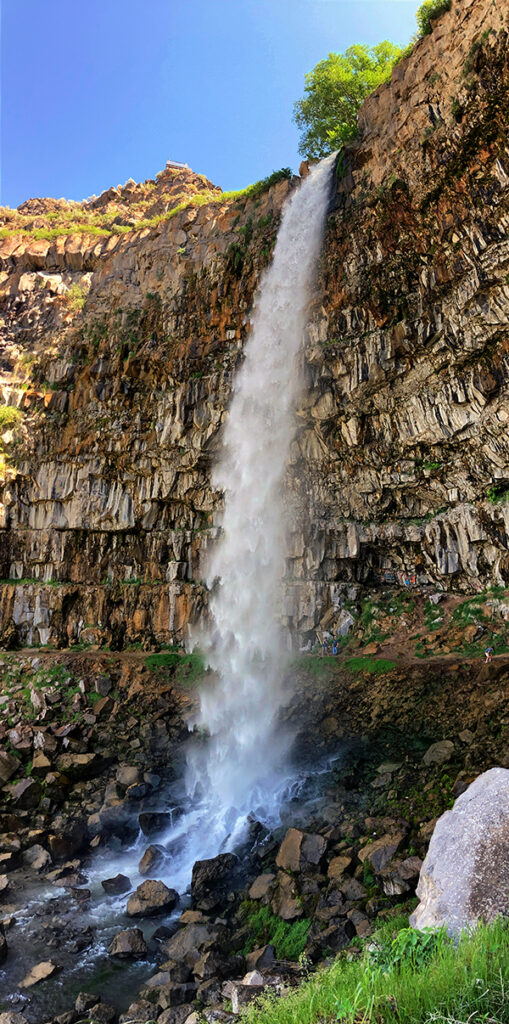
Perrine Coulee Falls drops 200 feet from the canyon rim in downtown Twin Falls, Idaho.
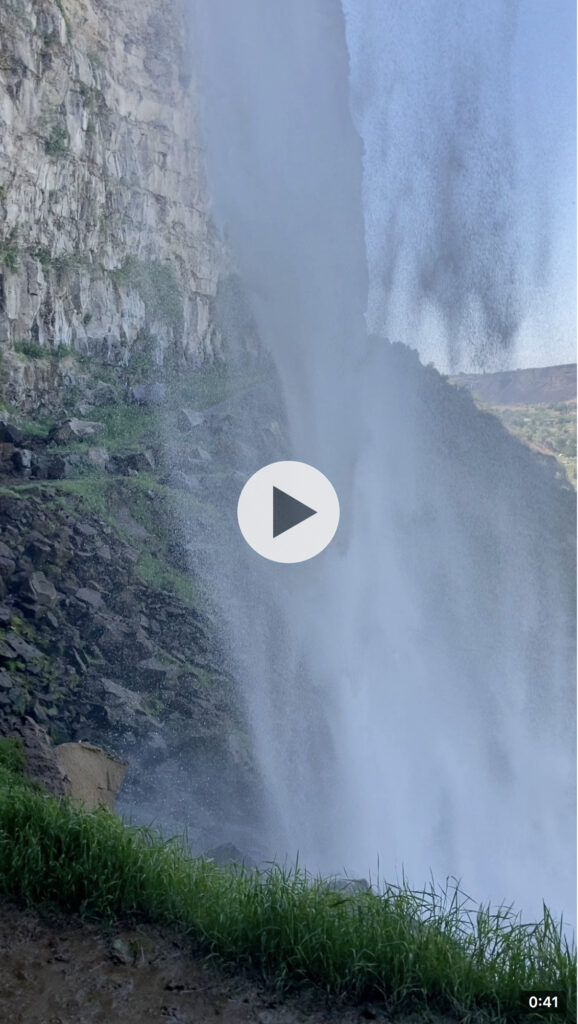
Click on the image to watch a short video of my walk behind the Perrine Coulee Falls.
SUN VALLEY
One hundred miles north of Twin Falls and nestled at the base of the Sawtooth Mountains is the town of Ketchum and the famous Sun Valley Ski Resort. Of course, there was nothing going on in June and the shops in Ketchum are out of my league but the drive was quite pretty.

Heading into the Sawtooth Mountains on the drive to Sun Valley, Idaho.
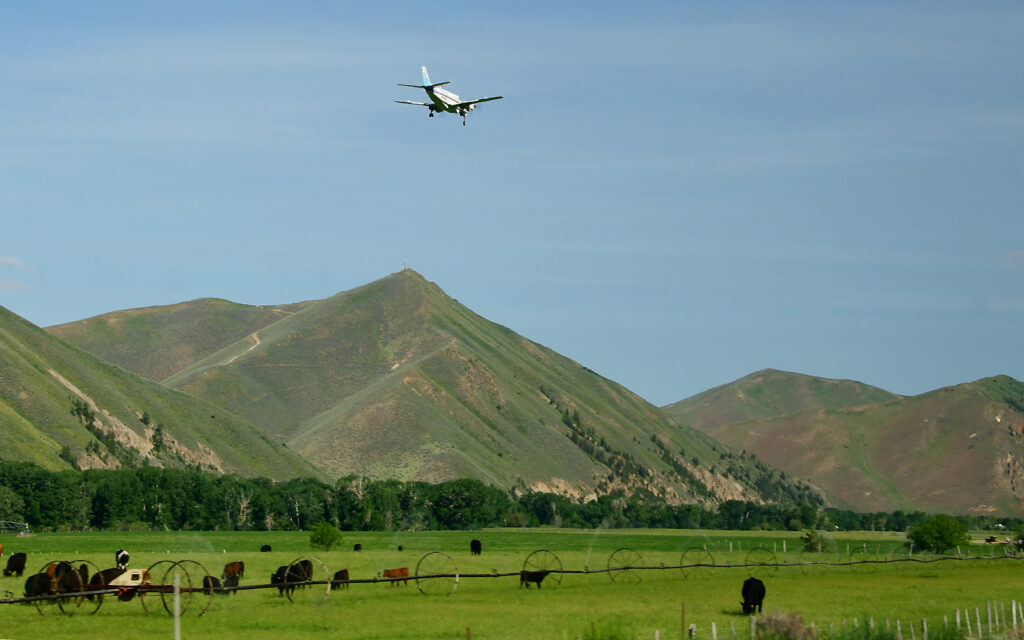
A small private plane startled me when it came from behind and flew parallel to the road on its approach to the municipal airport near Sun Valley.
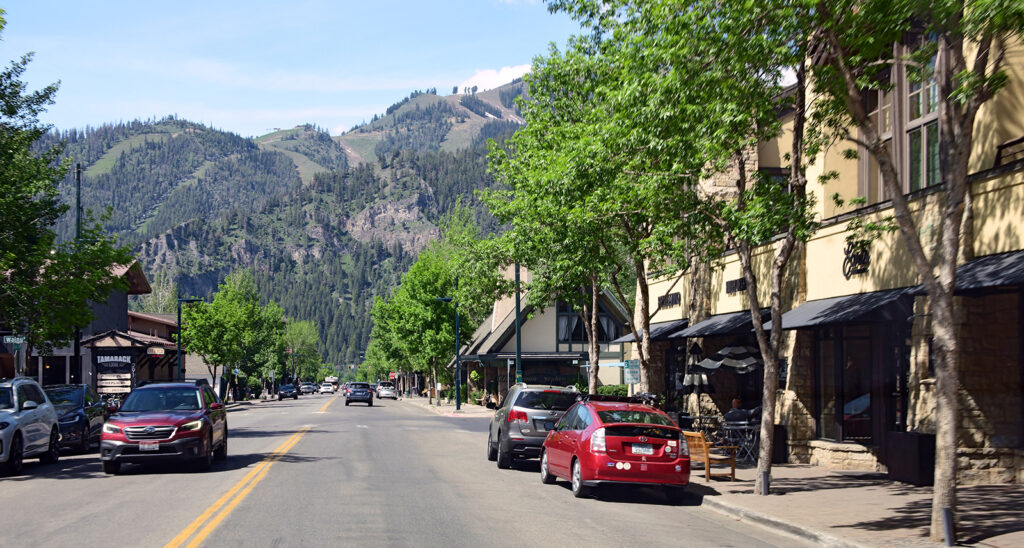
Downtown Ketchum, Idaho is full of high-end shops and restaurants that cater to the rich and famous who come here to ski in the winter.
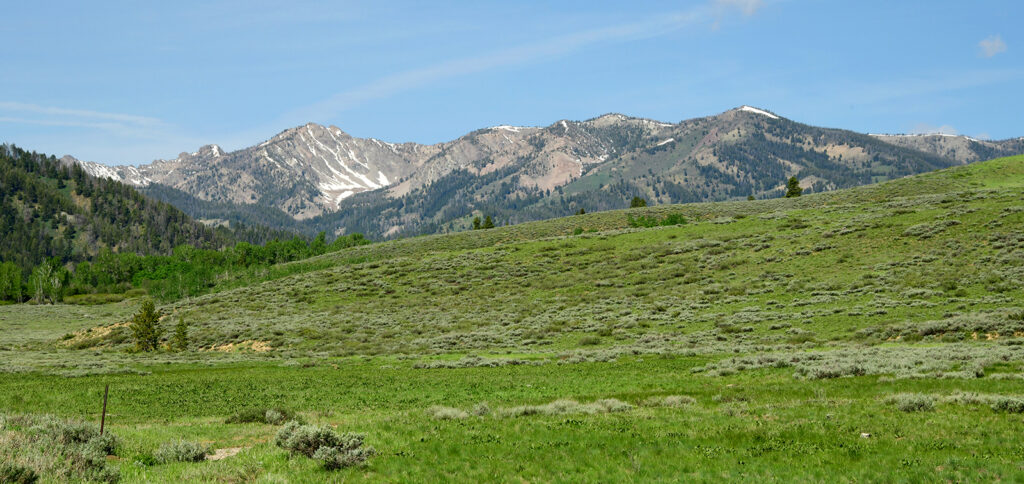
A bit of scenery in the Sawtooth foothills.
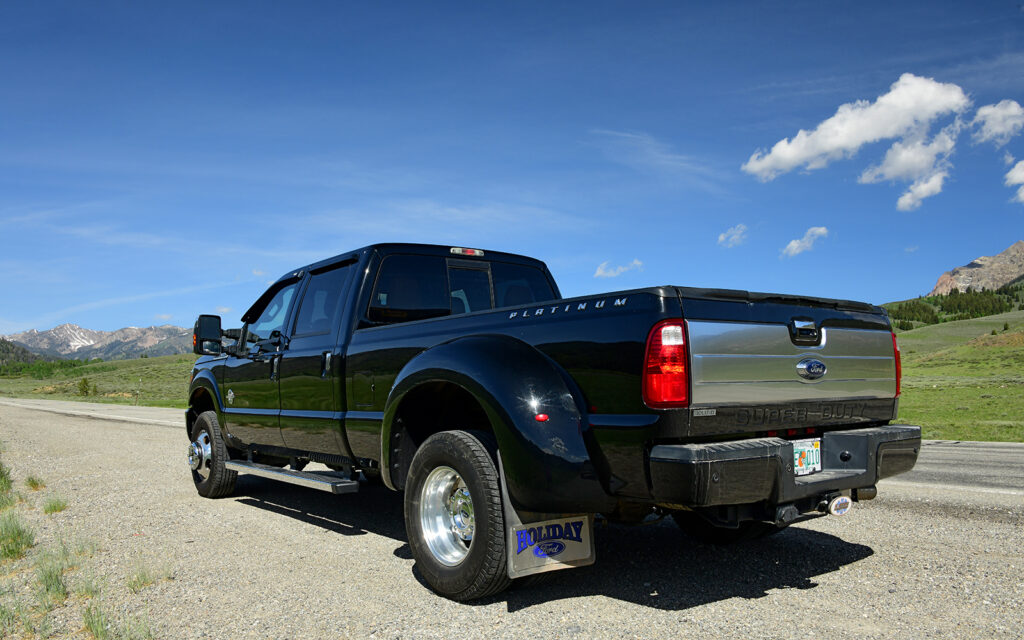
Another of my famous “Ford ads” with Idaho’s Sawtooth Mountains in the background.
CRATERS OF THE MOON NATIONAL MONUMENT
On my return trip from Sun Valley, I made a detour to Craters of the Moon National Monument. I’m fascinated with volcanic geology and this park boasts 25 cinder cones and a large lava field that is the result of eight separate volcanic eruptions over the past 15,000 years.

A pedestrian path leads to the mouth of a splatter cone at Craters of the Moon National Monument.
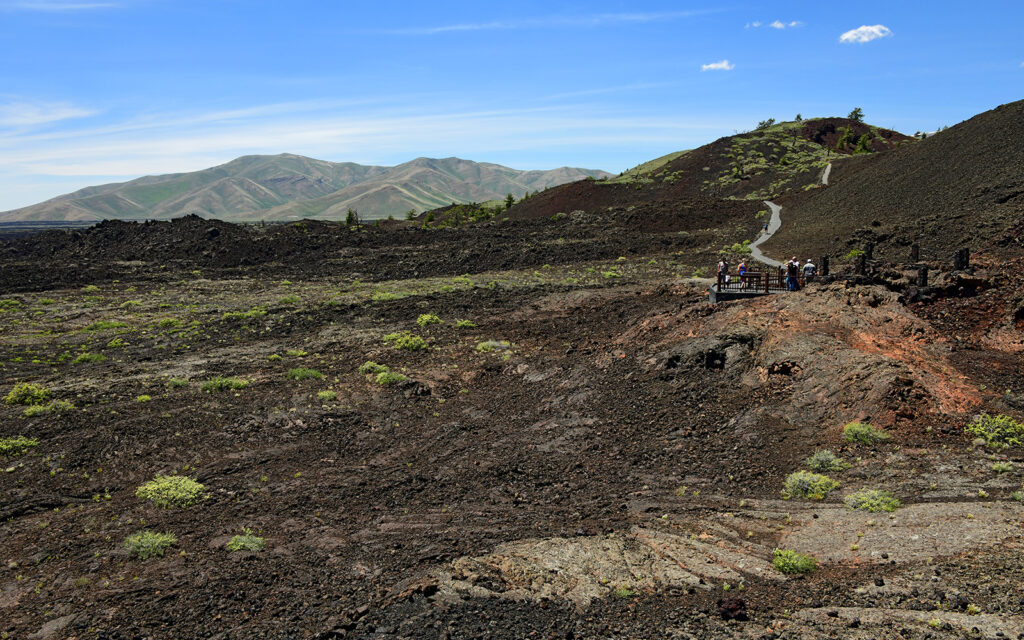
A view of the wide-spread lava field.
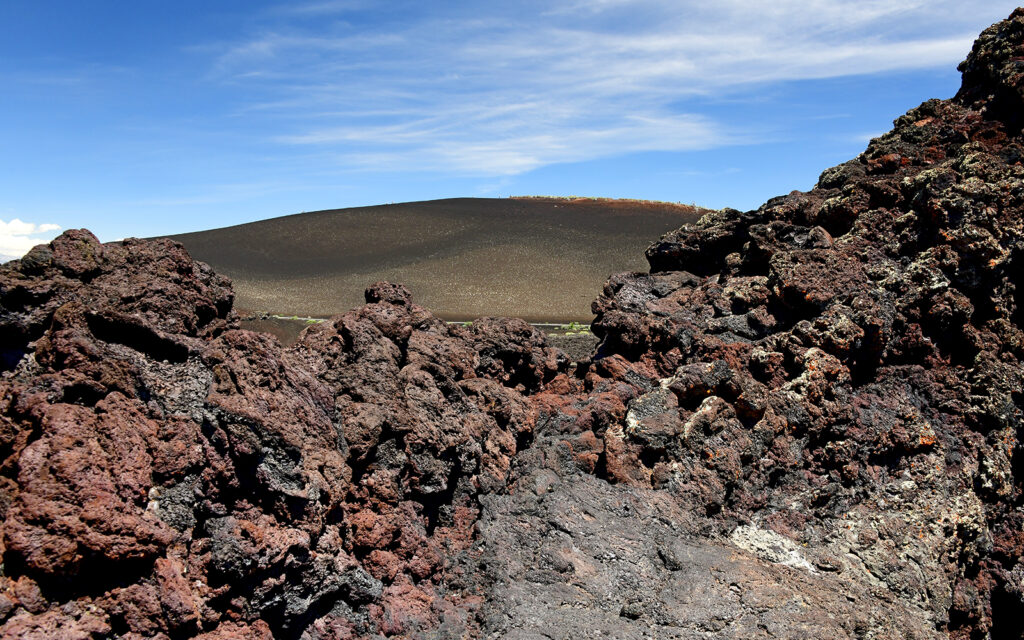
A contrast in textures between the rough rock of a cooled lava flow in the foreground and the fine pebbles of the “cinder” deposits beyond. Volcanic cinders are actually small bits of lava that were spewed into the air and cooled before hitting the ground, creating particles about the size of a walnut.
PRINCETON, OREGON – June 10-20, 2021
I now moved to southern Oregon and parked myself next to Malheur National Wildlife Refuge. I stayed at The Narrows RV Park, which included a cozy little restaurant, camp store, and fuel pumps that proved convenient because it was 25 miles to the nearest gas station. Now, mind you, I drove hundreds of miles while here but none of it took me in the direction of that town.
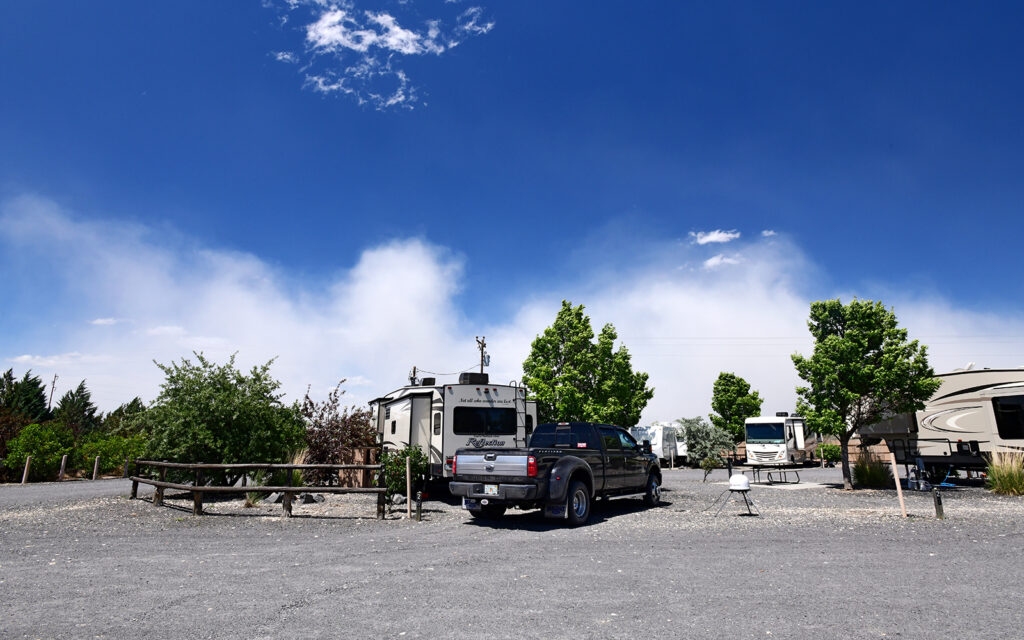
My campsite at The Narrows RV Park near Princeton, Oregon. Those aren’t clouds beyond the RV park. It’s smoke from a nearby wildfire. Luckily it never got too close.
MALHEUR NATIONAL WILDLIFE REFUGE
The refuge features a 42-mile auto tour route that I drove once in its entirety and a few more times in smaller sections. I picked up a guidebook at the Visitor Center that described each of the 19 interpretive stops along the route. This is a haven for migrating birds but in June, it was pretty quiet.
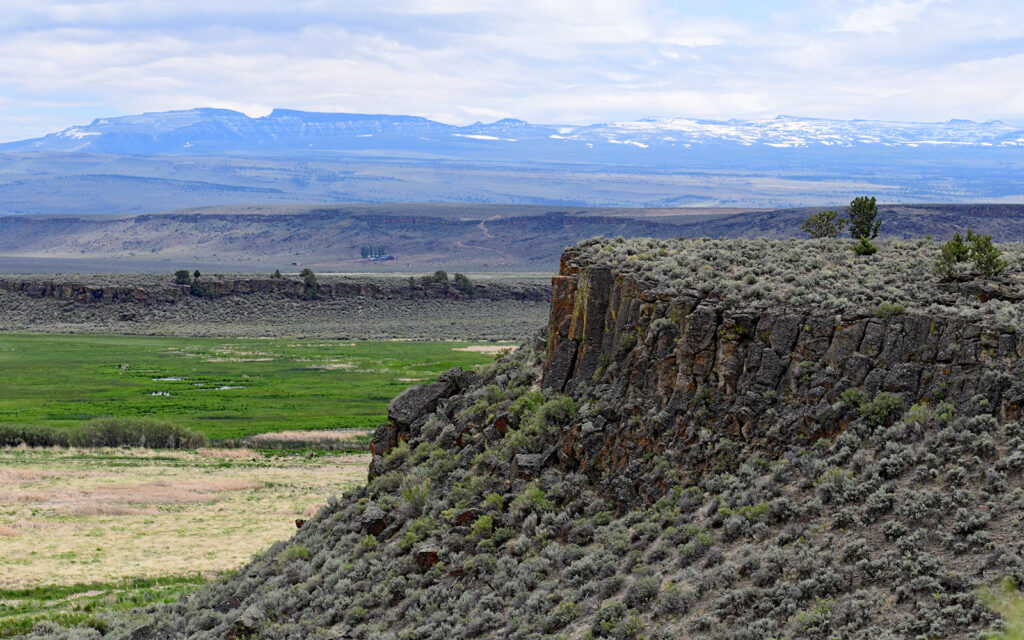
Buena Vista Butte overlooking Malheur National Wildlife Refuge in the Blitzen Valley in southern Oregon.
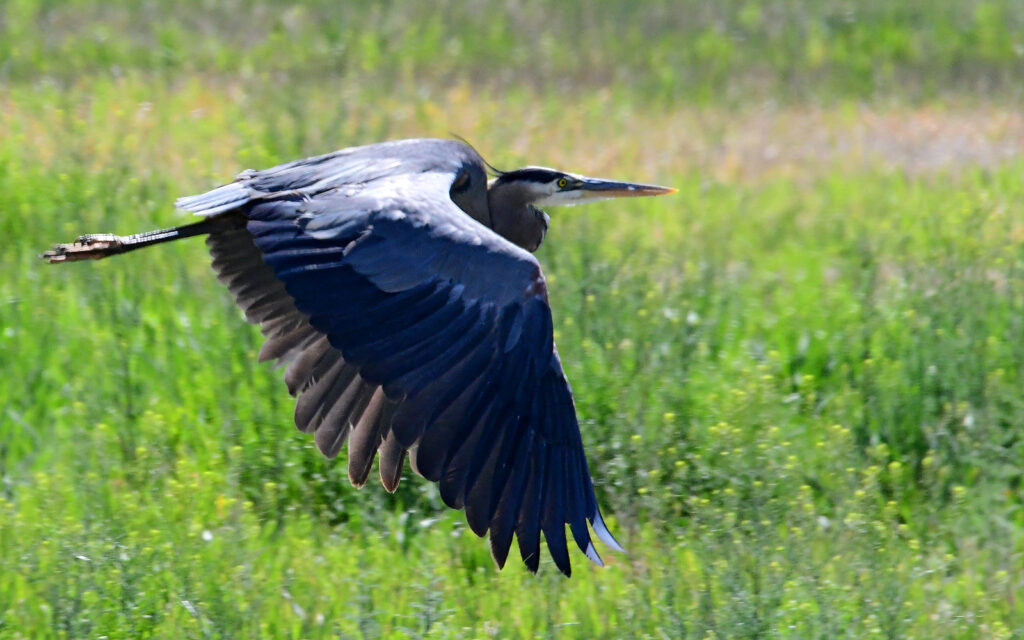
Great Blue Heron.
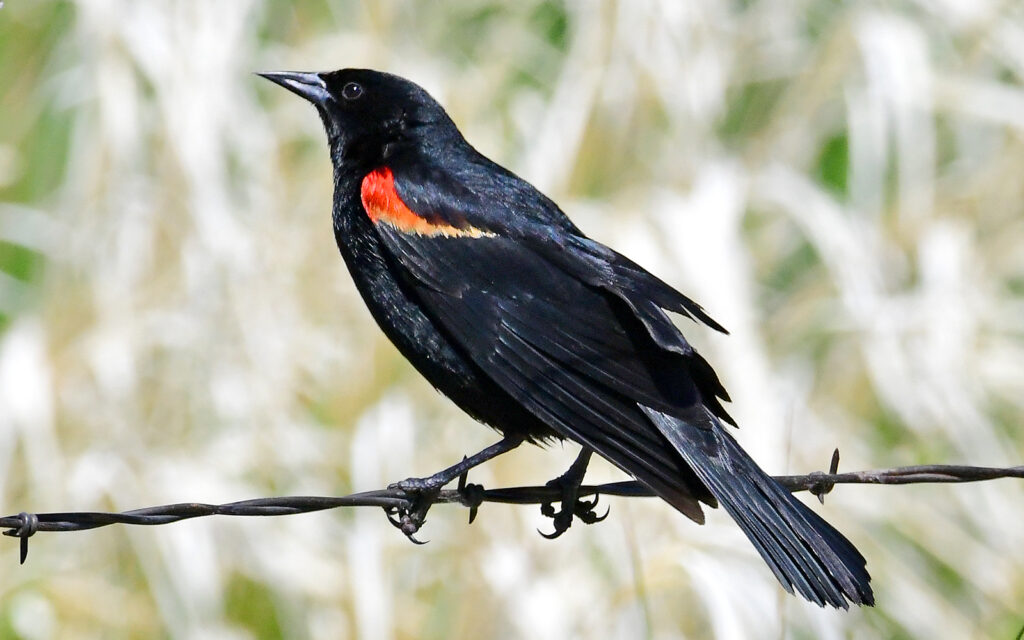
Red-winged Blackbird.
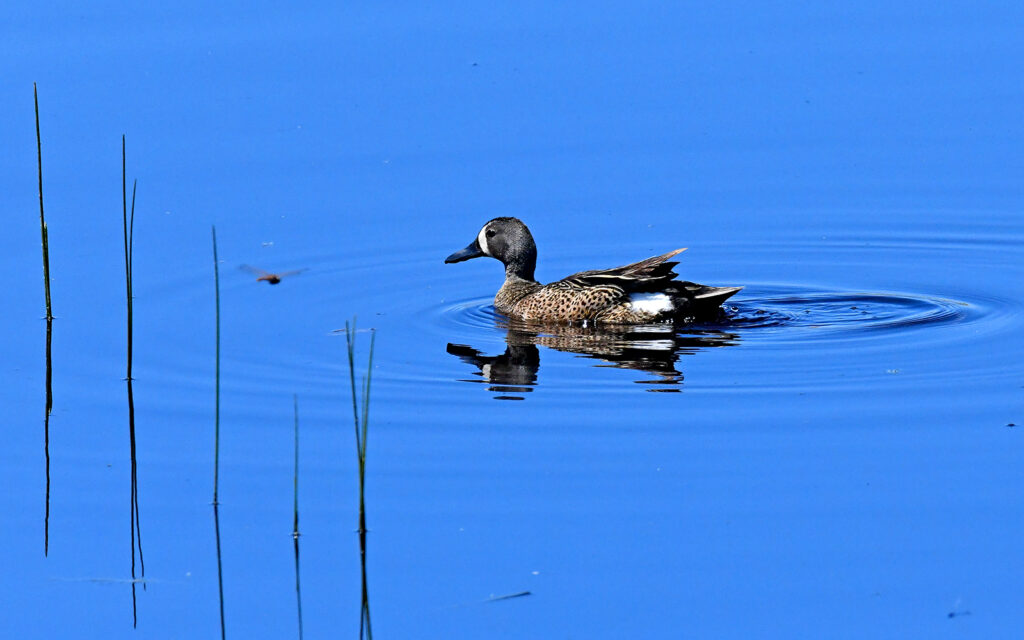
Duck with a dragonfly.
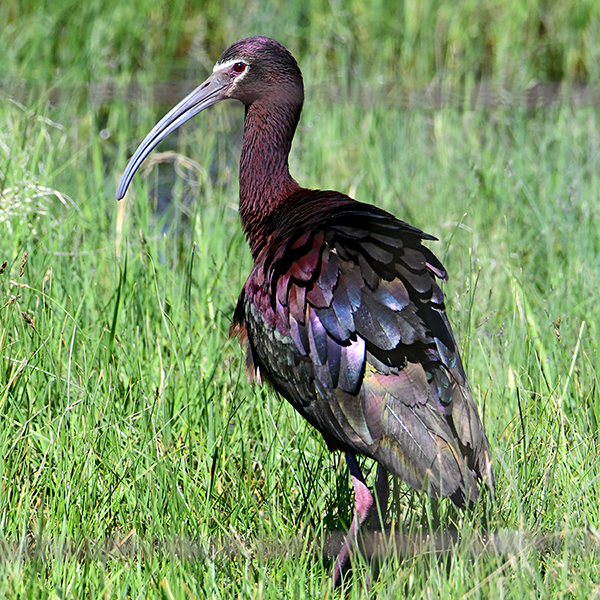
White-faced Ibis.

Yellow-headed Blackbird.
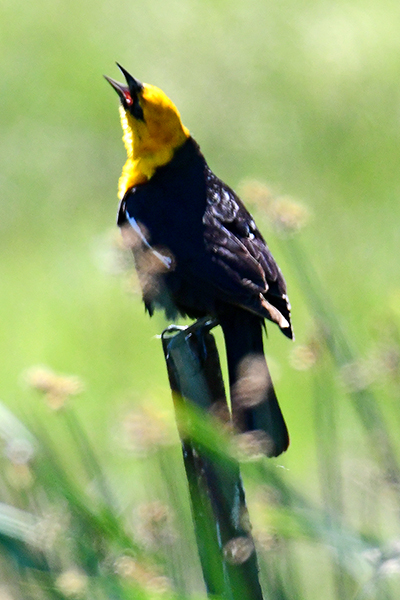
Yellow-headed Blackbird showing off.
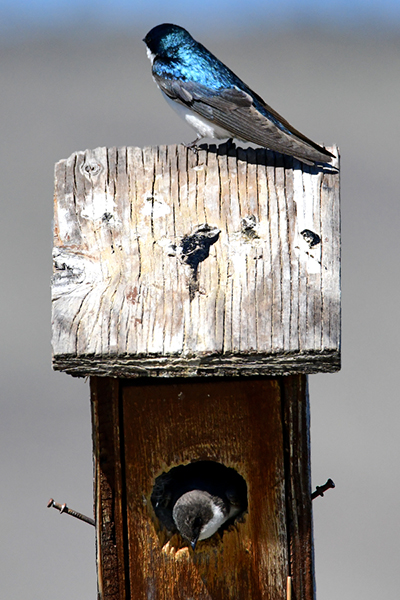
Tree Swallows: one in the house and one on the roof.
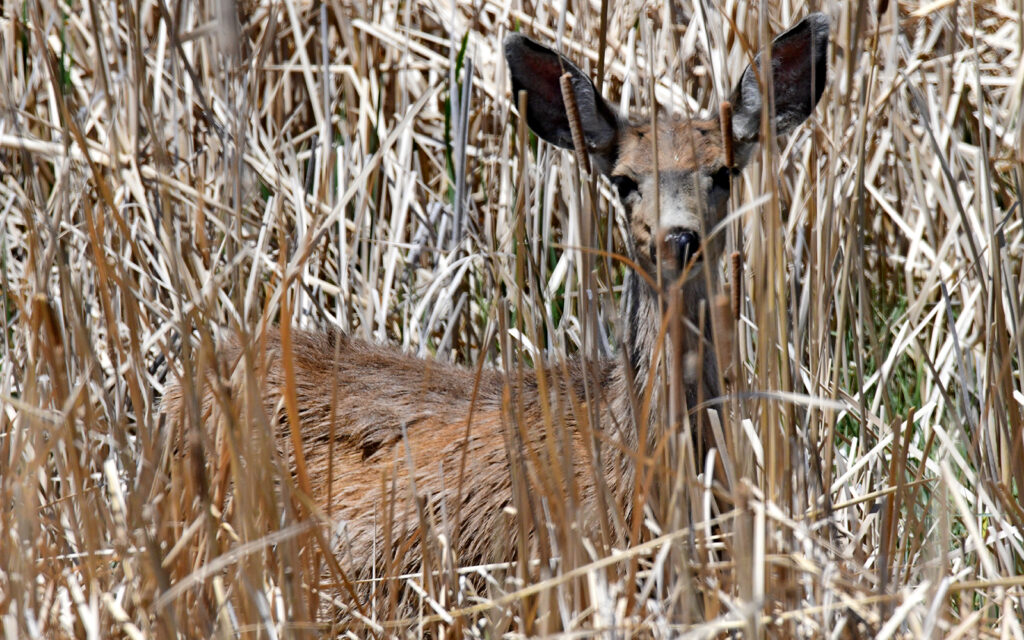
A well-camouflaged deer.
STEENS MOUNTAIN LOOP ROAD
Also known as Steens Mountain Back Country Scenic Byway, this 52-mile gravel scenic drive winds through a remote area of southeast Oregon. I didn’t drive the entire route but where I went was beautiful.
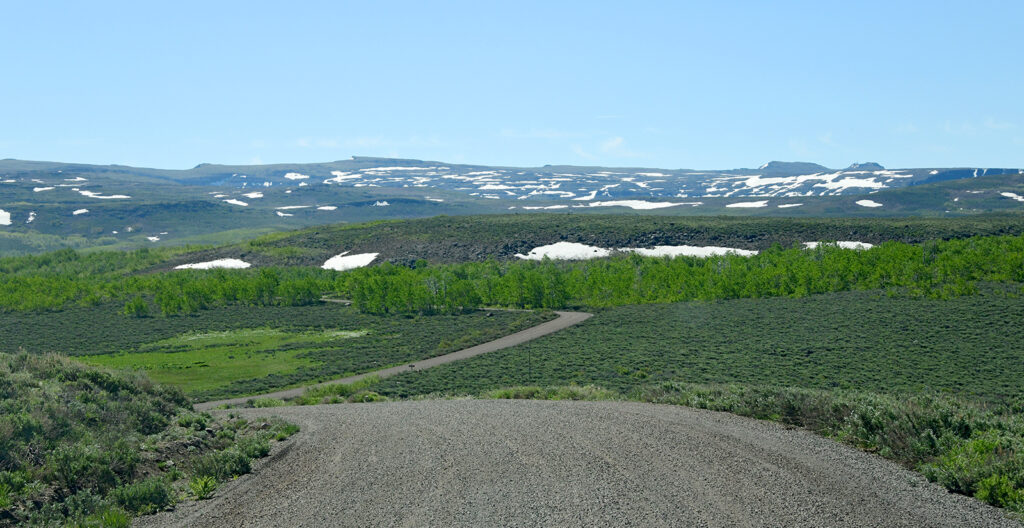
View along the Steens Mountain Loop Road.
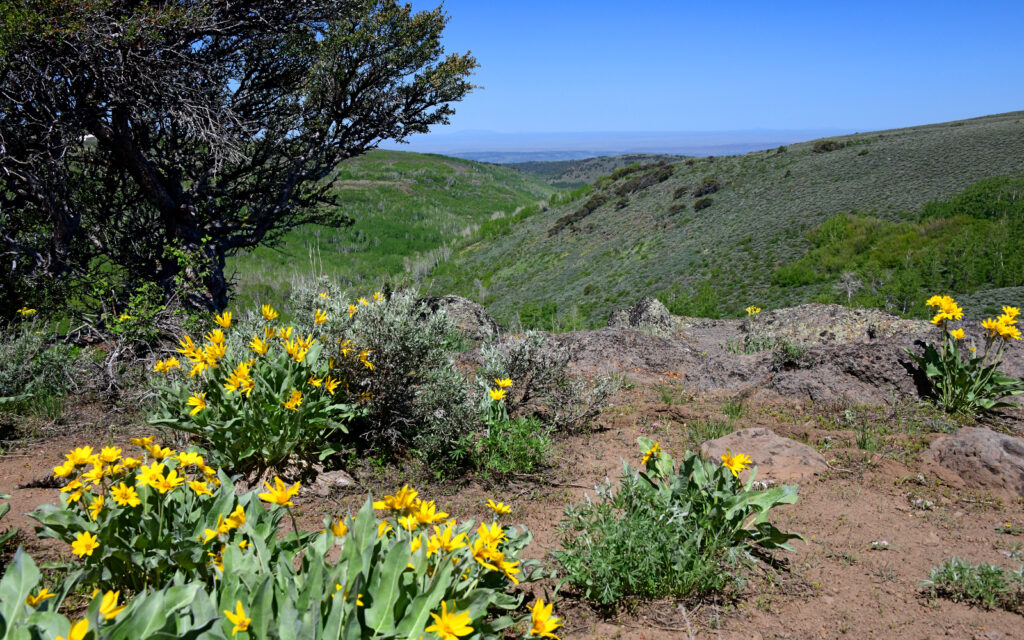
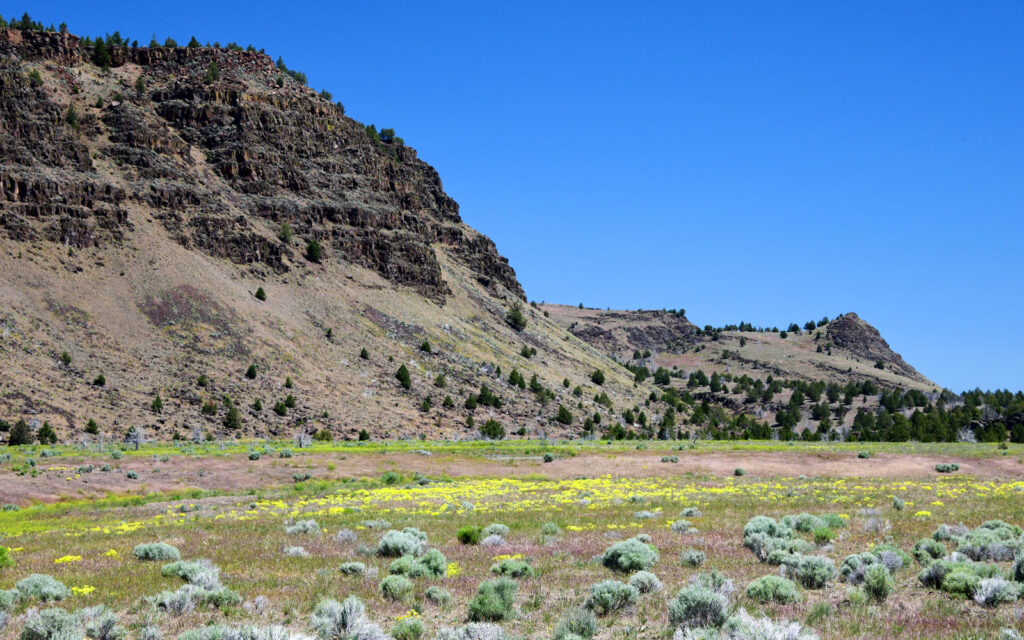
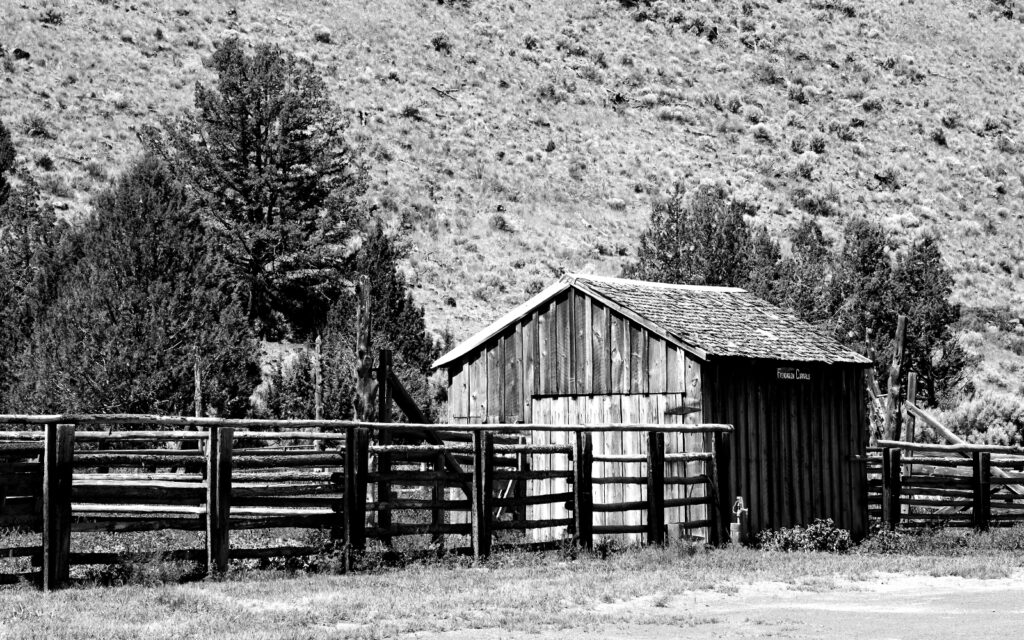
This weathered barn looks like it was plucked right out of the 1800s.
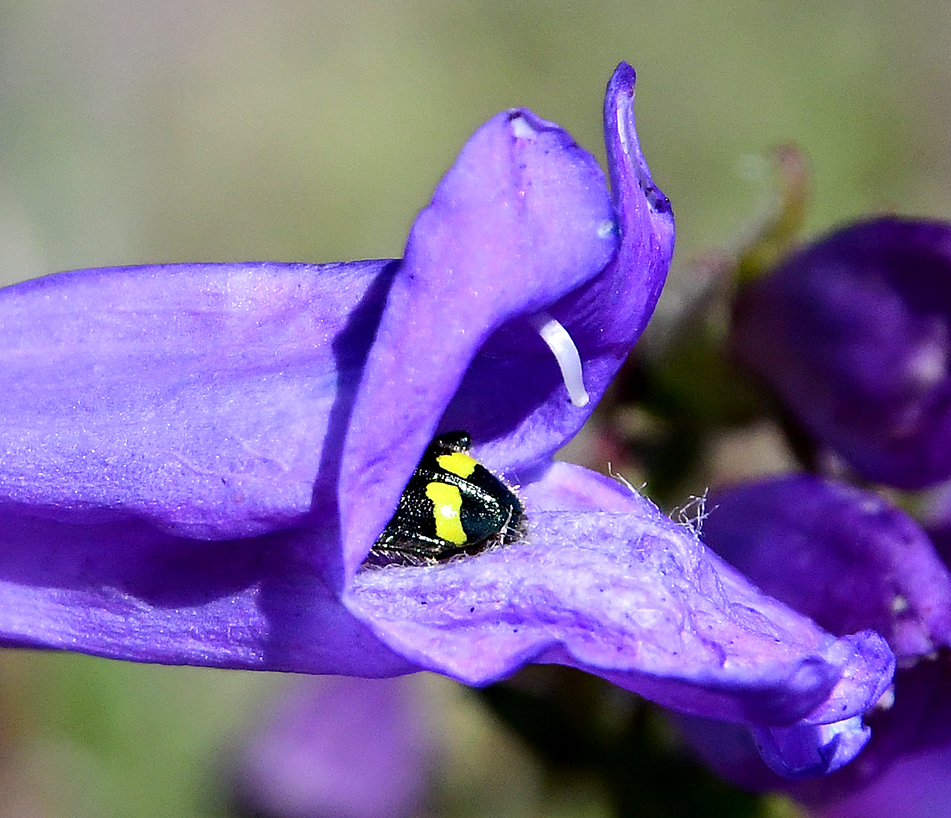
A beetle nestled inside a flower.
KIGER MUSTANG RESERVE
I was excited to learn there were wild mustangs nearby and set out to find them. Unfortunately, I couldn’t get any definitive information on where to find the Kiger Mustang Reserve. I found a road with a sign next to it marking it as the reserve so I set out to explore it. Not far in, the dirt road turned into barely a truck path, and 2o miles in, it ended at a locked gate. I saw plenty of cattle but not a single horse. The next day I learned from another camper that the horses were located somewhere else and by now, I had run out of time in this location.
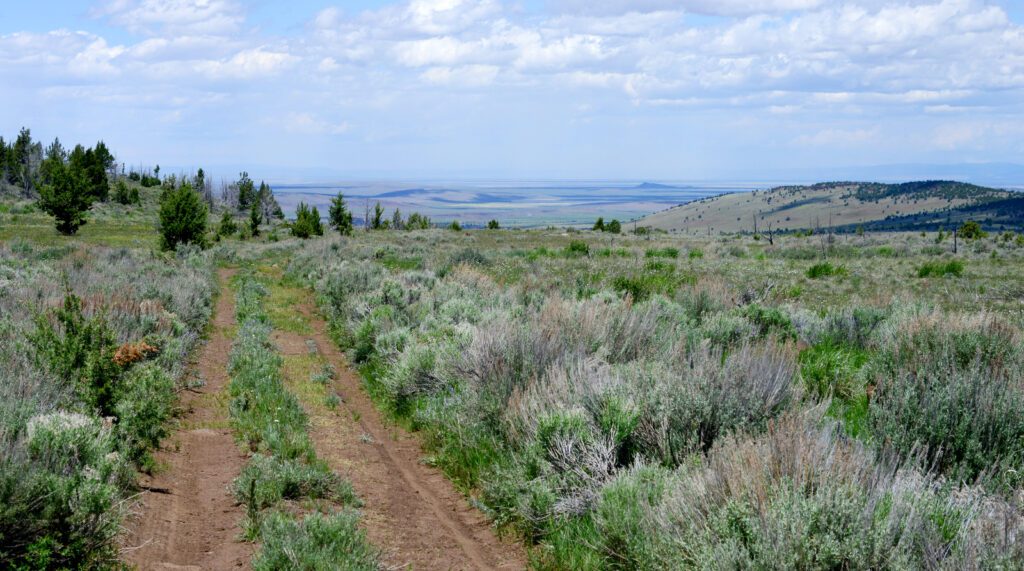
This is the best part of the 20 miles I drove through the countryside looking for wild mustangs.
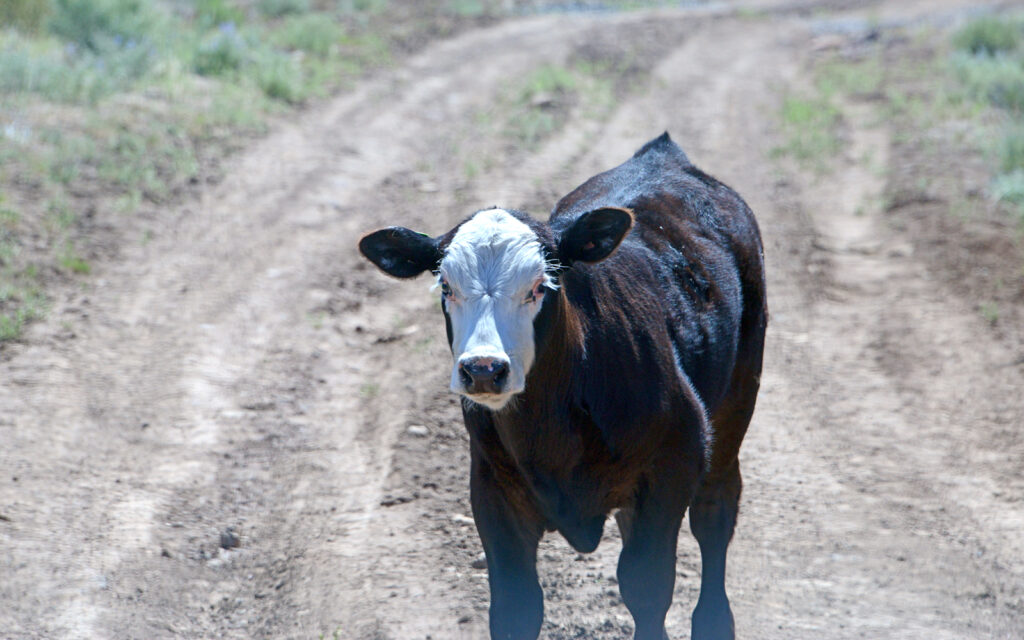
I never found the mustangs but there were plenty of curious cattle.
STARBUCK, WASHINGTON – June 20-28, 2021
Walla Walla is such fun to say that I just had to pass through this town on my way to my next stop in southeast Washington. I spent eight days at Tucannon River RV Park near the tiny town of Starbuck. I was here to see a waterfall.
June of 2021 brought all-time record high temperatures to Washington and the eastern part of the state wasn’t spared. It reached 106° on the day a wedding was taking place in the campground. It was the shortest ceremony in history—5 minutes at best—then, everyone ran for cover in the shade or back to their campers for the air conditioning. Keep in mind that the average high temperature here in June is in the upper 60s and in August it gets all the way to 80°!
I was surprised by the landscape here. The southeastern part of Washington is the only region without mountains. Instead, it is covered in rolling hills that resemble a pile of wrinkled sheets and every inch of it is planted with wheat and corn. Some of the hills look to be impossible to navigate with a tractor or combine. And unlike the rest of the state, the climate here is quite dry.
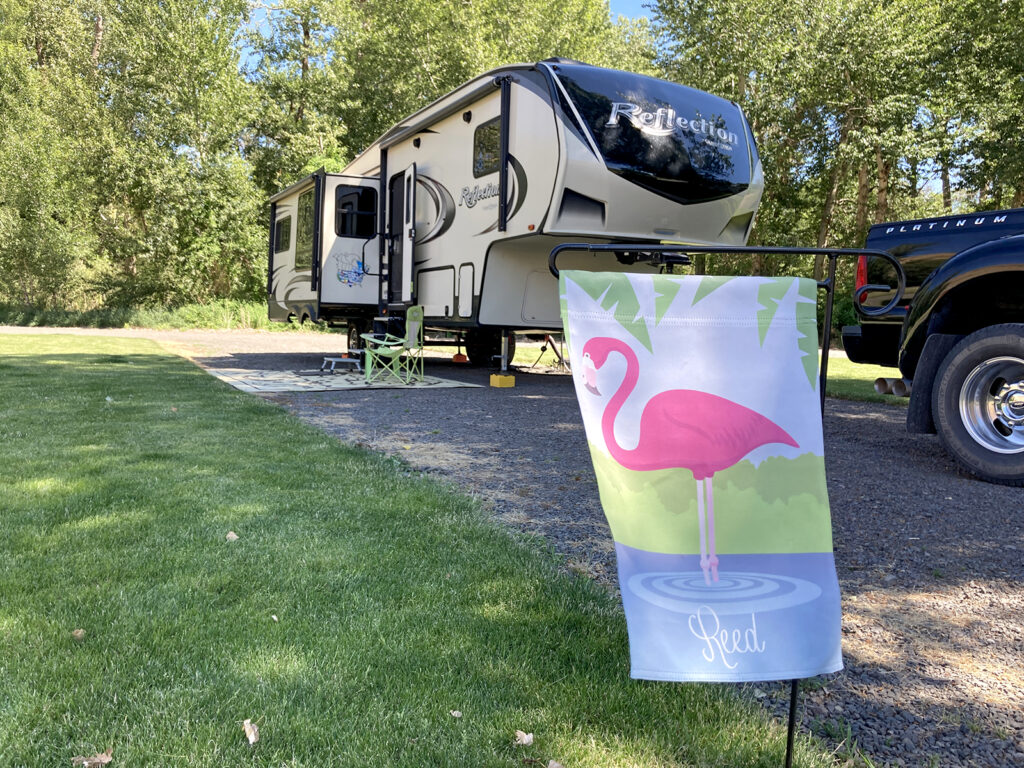
My site at Tucannon River RV Park. Thankfully, it was shaded most of the day.
Scenery between Walla Walla and Starbuck, Washington:




It hit a record-high temperature of 106° the week I was here.
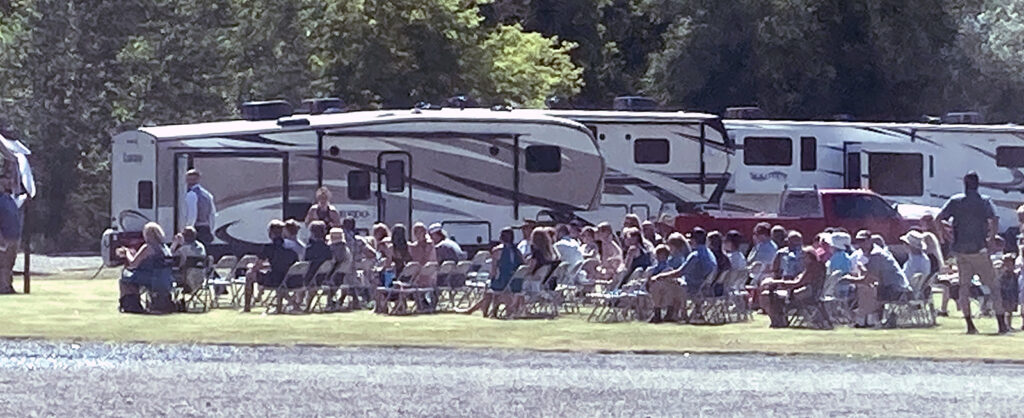
This wedding took place on the hottest day.

Sunset view from my trailer.
PALOUSE FALLS
The reason I chose this remote location was for the Palouse Falls, a 200-foot drop of the Palouse River on its way to the Snake River.
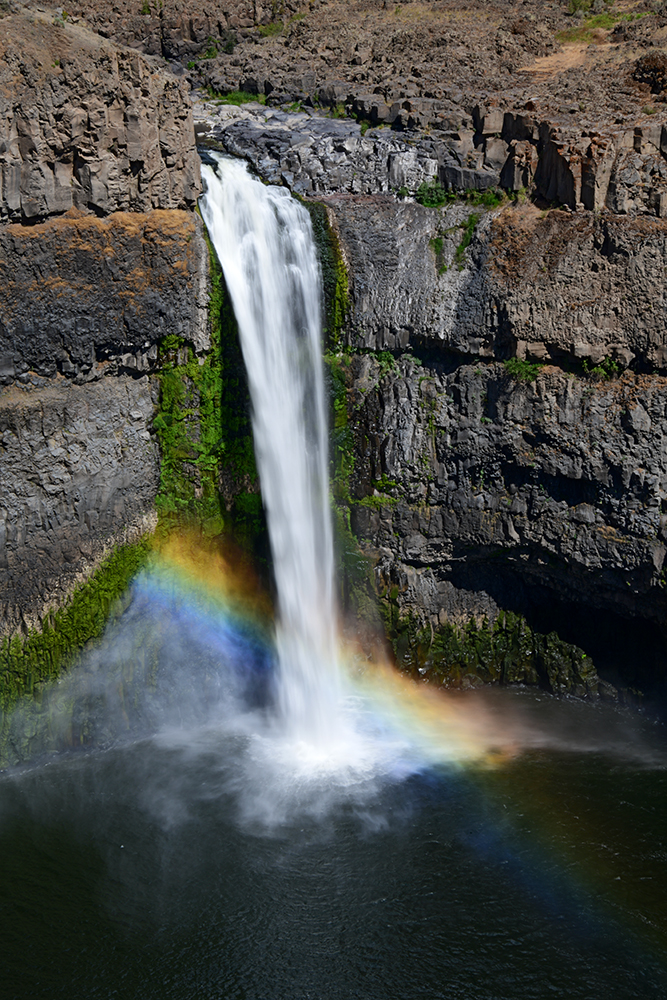
The Palouse Falls drops 200 feet into a canyon.
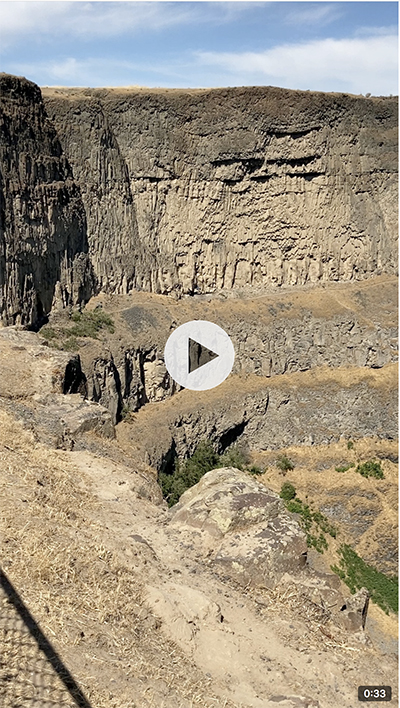
Click on the image for a panoramic view of the falls and the canyon.
SPOKANE, WASHINGTON – June 28-July 6, 2021
This was the largest city I’d seen since Las Vegas in February and would be for the remainder of my travels this year. I’m not a big fan of cities in general so the most exciting thing for me was an automatic car wash that welcomed dually pickups. I went three times this week! Yes, “Big Ass Truck” was THAT dirty.
With temperatures still over 100°, I couldn’t let Cleo stay in the trailer during the move from Starbuck so I set up her crate in the back seat of the truck. I plugged in a cat pheromone dispenser and she remained in a calm, almost stoned state until we arrived at the Spokane KOA.
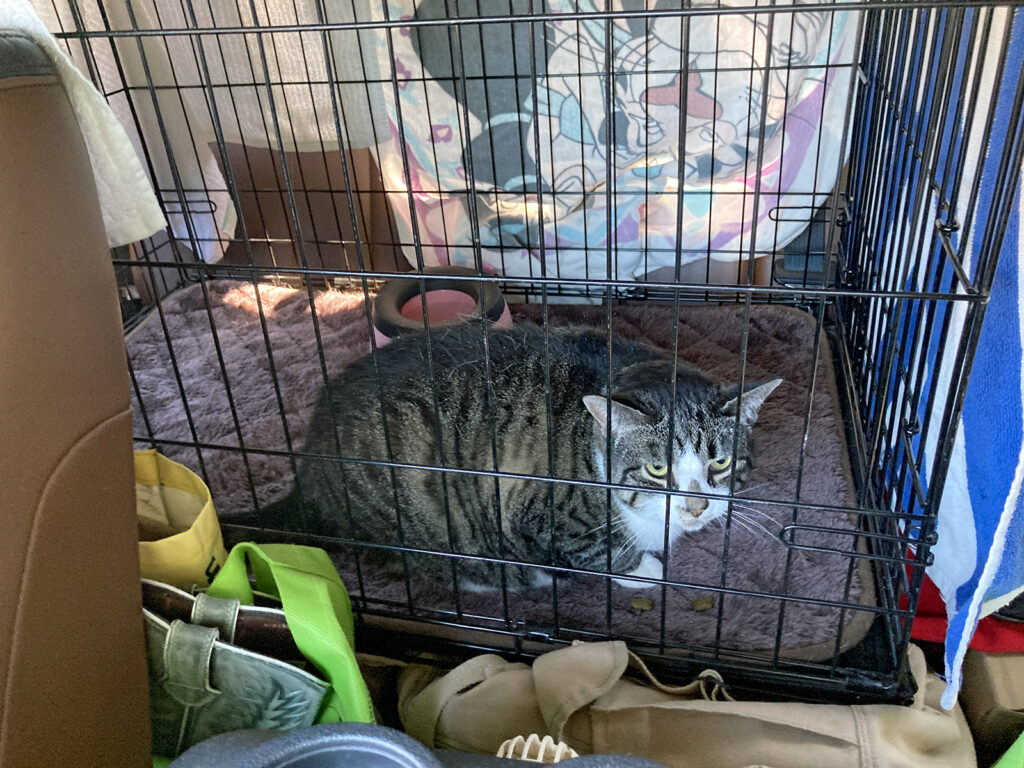
Cleo got to ride like a queen in the back seat of the truck. It was far too hot to have her ride in the trailer as she usually does.
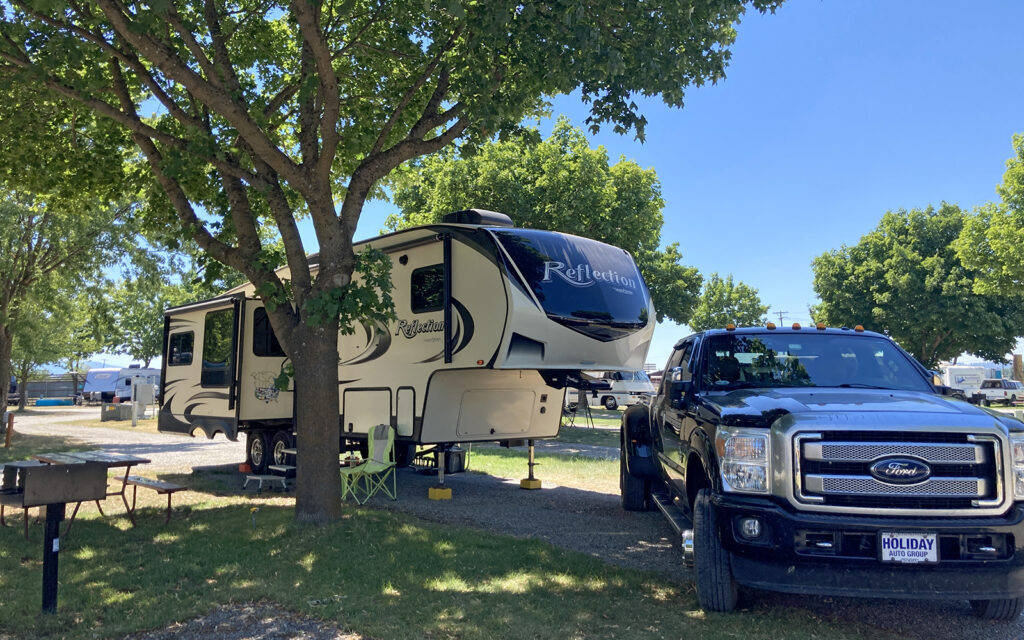
My spot at Spokane KOA.
I was also excited to learn the Idaho Potato Truck would be at the July 4th celebration in Couer d’Alene, Idaho so I made the half-hour drive. The lakefront park was lovely and the fair was small but nice. I hung around all afternoon but the truck never showed up. On my drive back to Spokane, I couldn’t believe it but it passed me going the other way on the interstate so although I didn’t get any pictures, I still saw it, which was pretty cool.
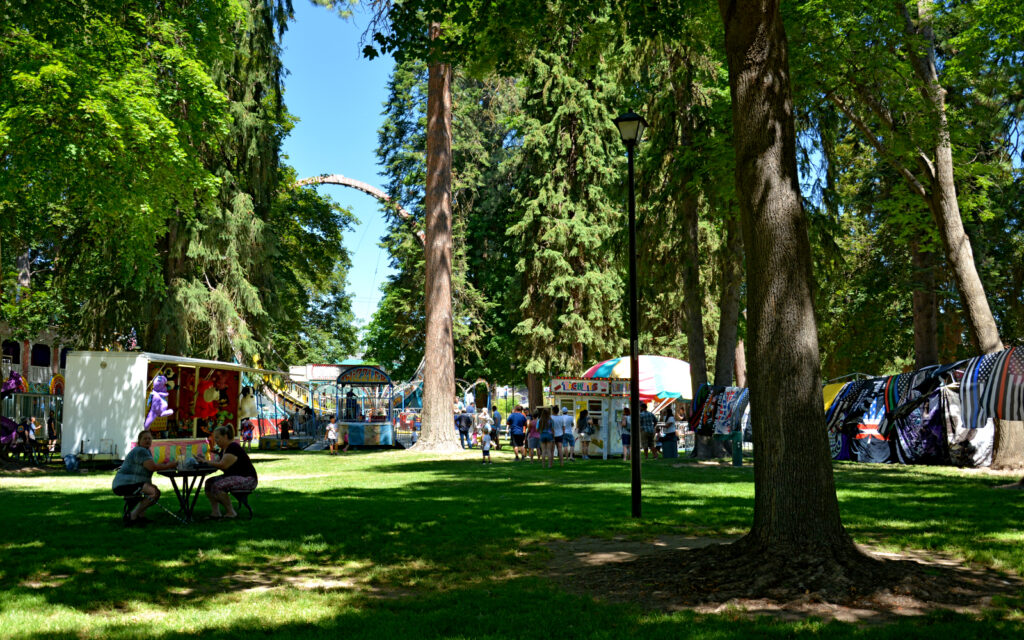
July 4th festival in Couer d’Alene, Idaho.
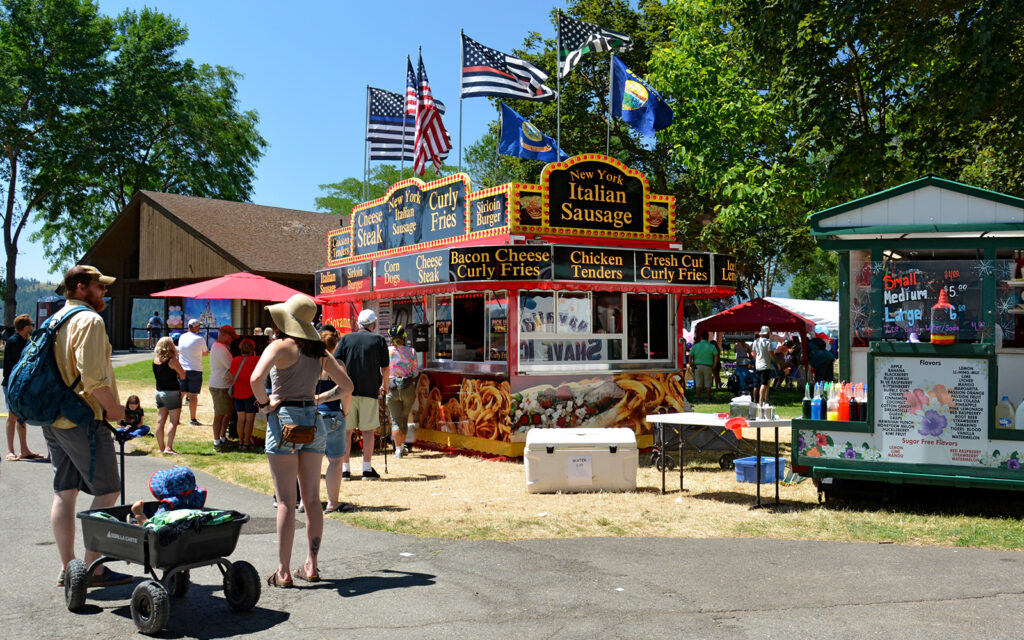
Food trucks at the July 4th festival in Couer d’Alene, Idaho.

People enjoy the beach and swimming in the lake at the July 4th festival in Couer d’Alene, Idaho.
MOYIE SPRINGS, IDAHO – July 6-13, 2021
Located just 25 miles from the Canadian border, this part of Idaho is what I always envisioned the state to look like: heavily forested mountains and wild rivers. I expected to see Bigfoot behind every tree! Twin Rivers Canyon RV Park is exactly as named. It sits at the bottom of a canyon at the confluence of the Moyie and Kootenai Rivers. Because of its location, there was no cell phone service, WiFi, or satellite TV. I had to drive a half hour to Bonners Ferry to use my phone.
The driveway into this campground was the most treacherous, white-knuckle drive I’ve ever done with or without an RV. It’s a 500-foot drop in elevation from the highway to the canyon floor. The driveway is one lane wide with four hairpin switchbacks to negotiate with my truck and trailer (50 feet total length). All you can do is pray no one is coming in the other direction. I’ve included a video so you can enjoy the ride as much as I did.
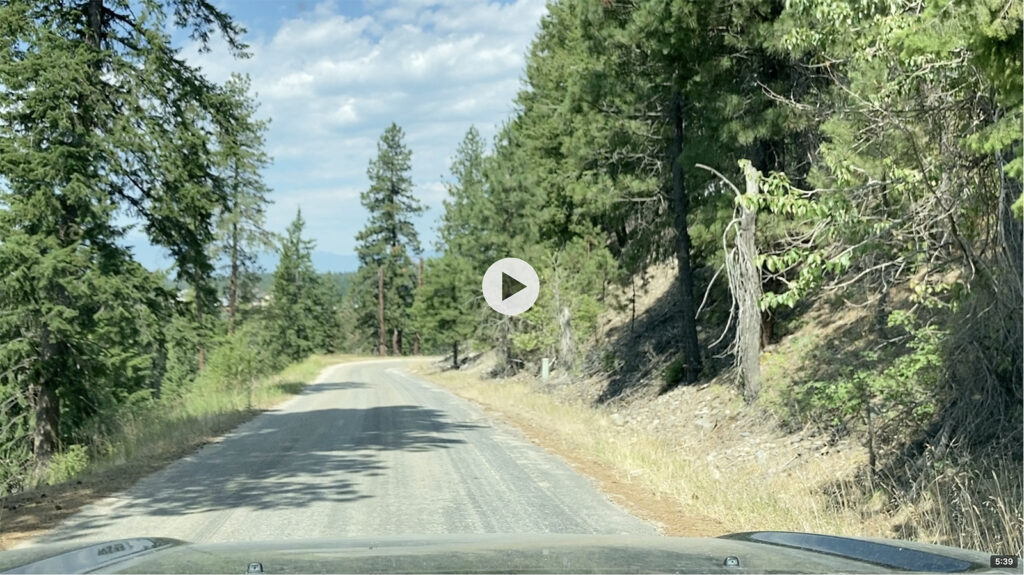
Click on the image to watch the white-knuckle drive down to the campground.
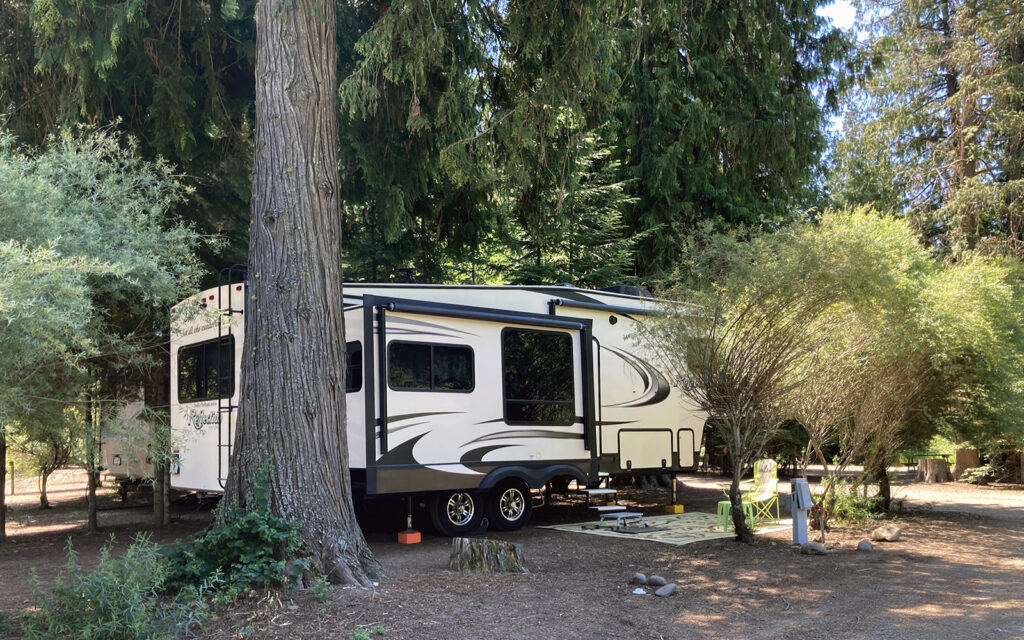
Once I arrived, I had a lovely shaded campsite near the river.
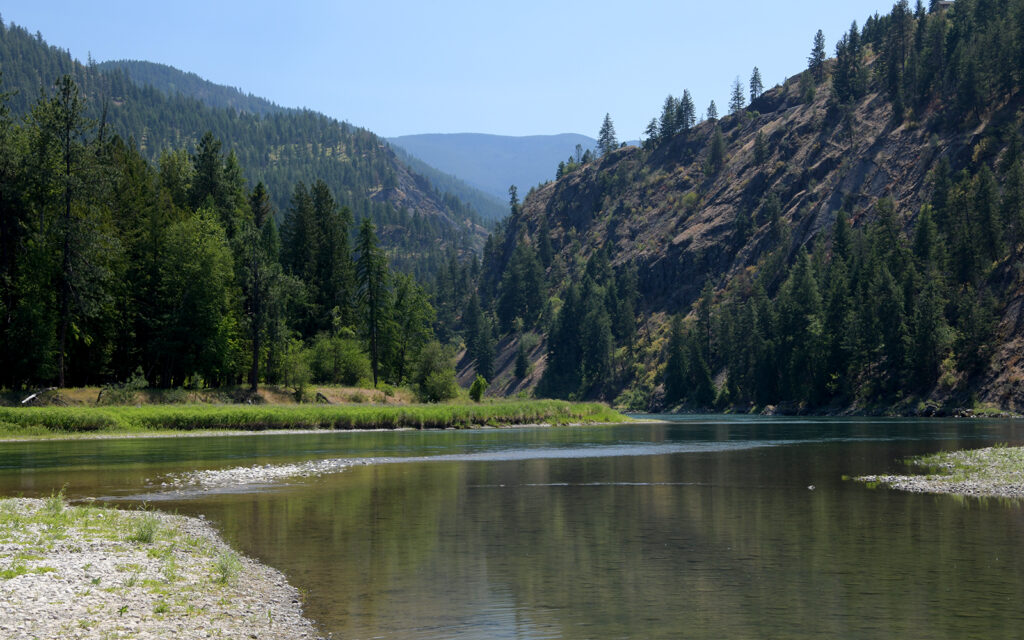
The boat launch area of the campground where the Kootenai River is joined by the Moyie River coming in from the left. This is a popular place to fish.
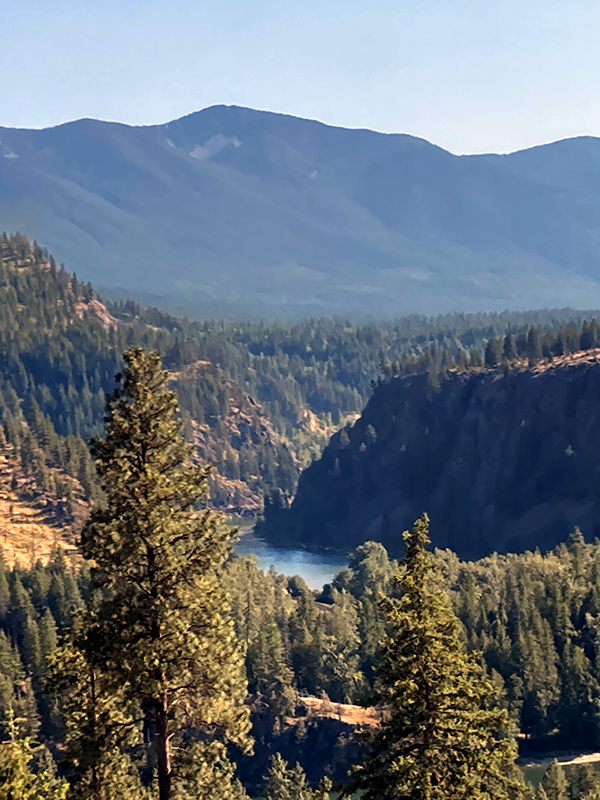
The Kootenai River Valley.
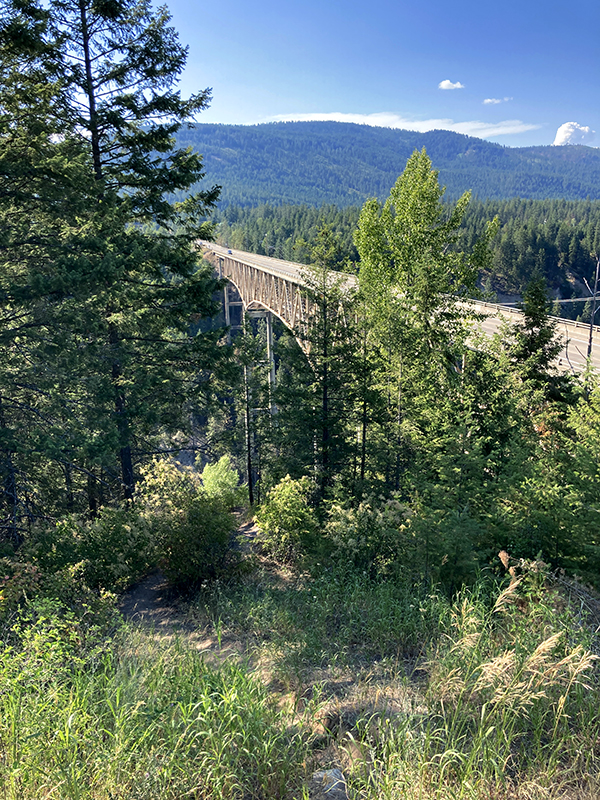
The Moyie River Canyon Bridge.
COPPER FALLS
Located just a mile from the Canadian border in the Kootenai National Forest is a short hiking trail to Copper Falls that drops 225 feet. Although the hike was short, there were a lot of signs posted warning of bears so I was a little nervous. I got to the waterfall, took my photos, and as I was packing up, a man came up the trail carrying bear spray in his hand with his finger on the trigger, a .357 Magnum in a holster, and a .22 in his pocket. This guy was taking the bear warnings seriously!
I struck up a conversation with him and found out his name is Francisco and was originally from Mexico but came to California as a teen to work as a migrant farmer. A few years ago, he wanted a change of scenery so he moved to southern Idaho where he worked on potato farms. Now he’s as far north as you can get in this state and living full-time in an RV at a campground not far from where I was staying. He said he takes the bear danger very seriously and always goes into the woods prepared for battle. I asked if I could walk with him back to the parking lot.

Copper Falls drops 225 feet.

Francisco came “loaded for bear.” Literally!
KOOTENAI NATIONAL WILDLIFE REFUGE
Located in Bonners Ferry, Idaho is Kootenai National Wildlife Refuge, a 3,000-acre reserve with a free 5-mile auto tour route and even a waterfall.
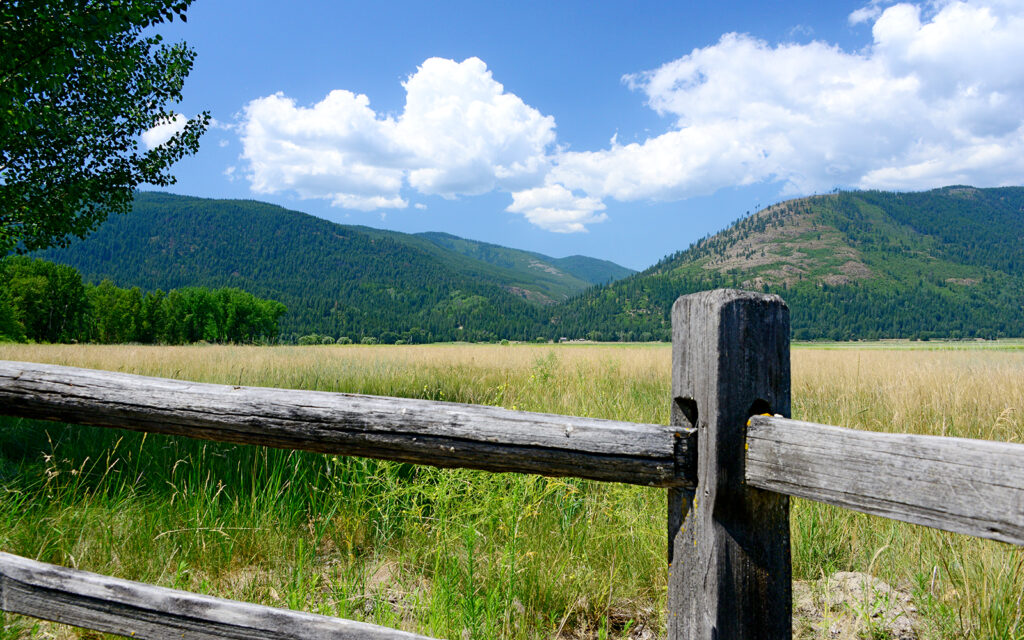
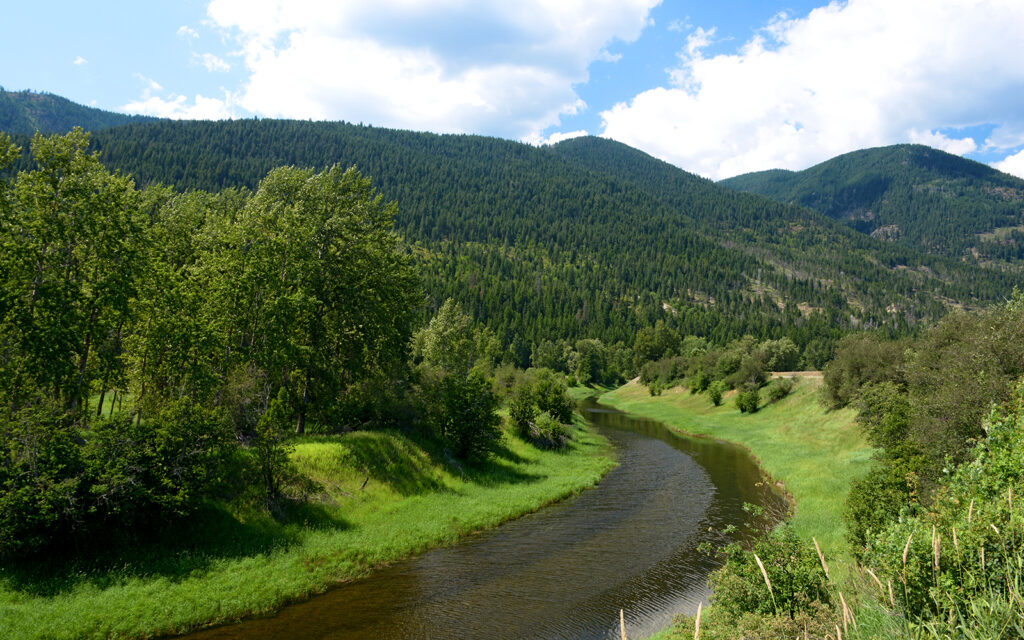
Myrtle Creek winds its way through the refuge.
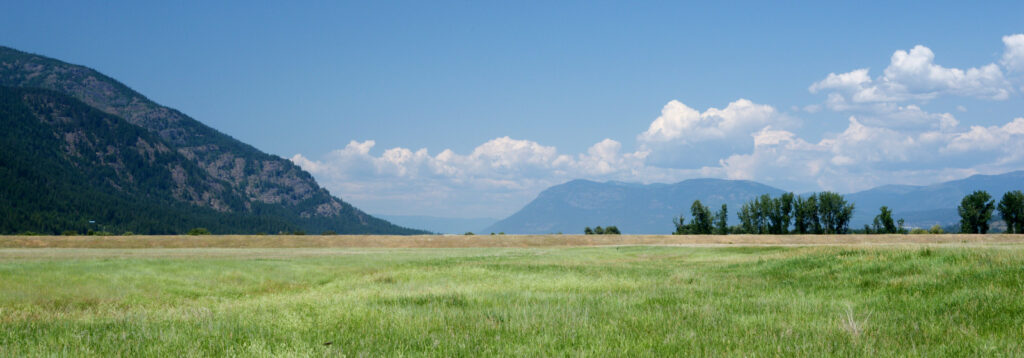
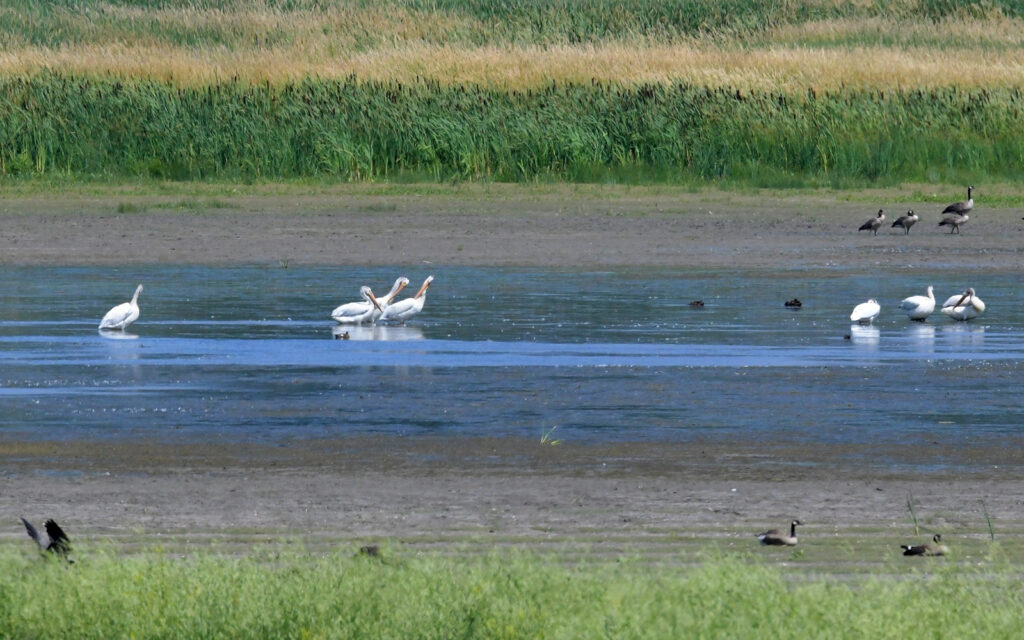
Pelicans and geese making the most of what remains of the wetlands in mid-summer.
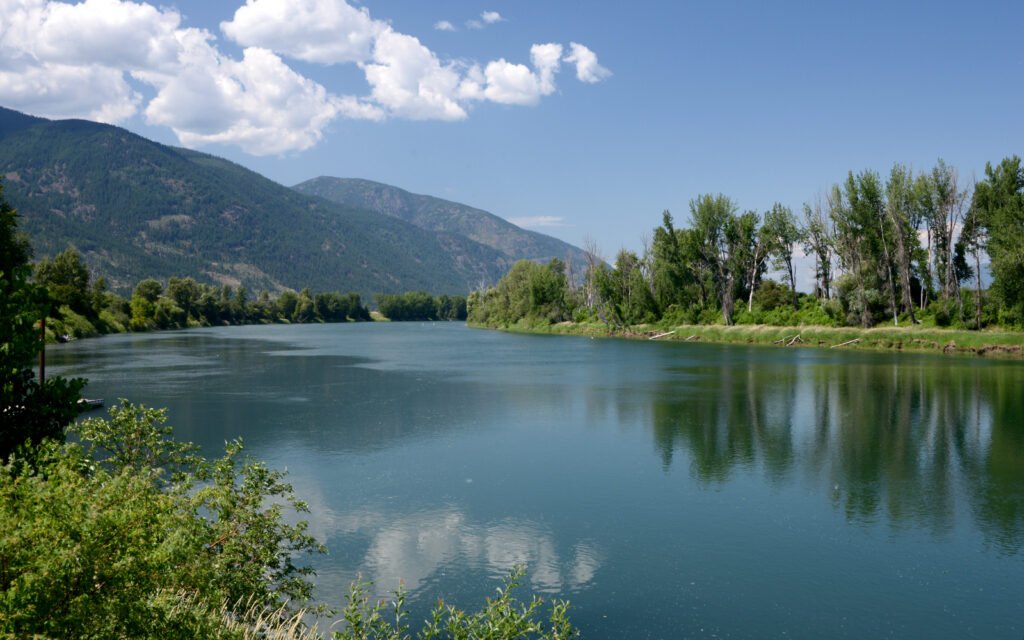
The Kootenai River forms the north and east boundaries of the refuge.
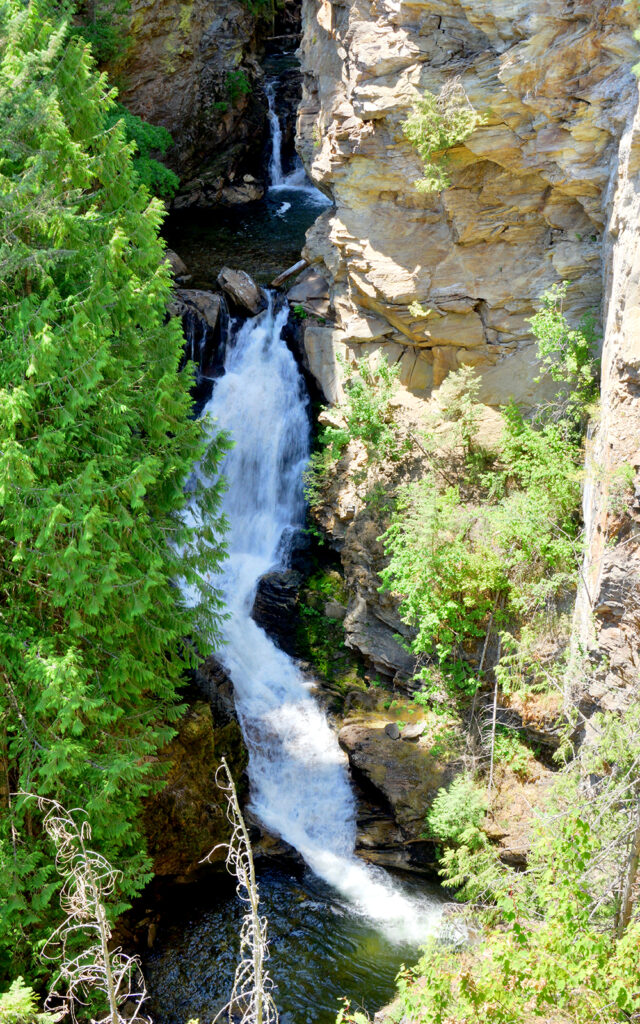
Myrtle Falls in Kootenai National Wildlife Refuge.
KOOTENAI FALLS
Just over the border into Montana is Kootenai Falls, one of the largest waterfalls by volume in the United States. The river drops 300 feet over a distance of a few hundred yards. I spent an entire afternoon here because it’s just so beautiful. Even with all that water flow, it was very peaceful.
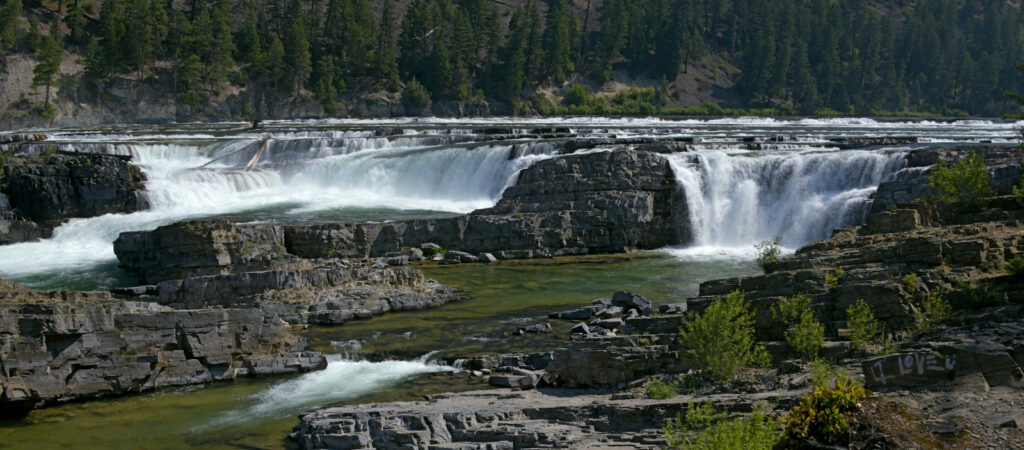

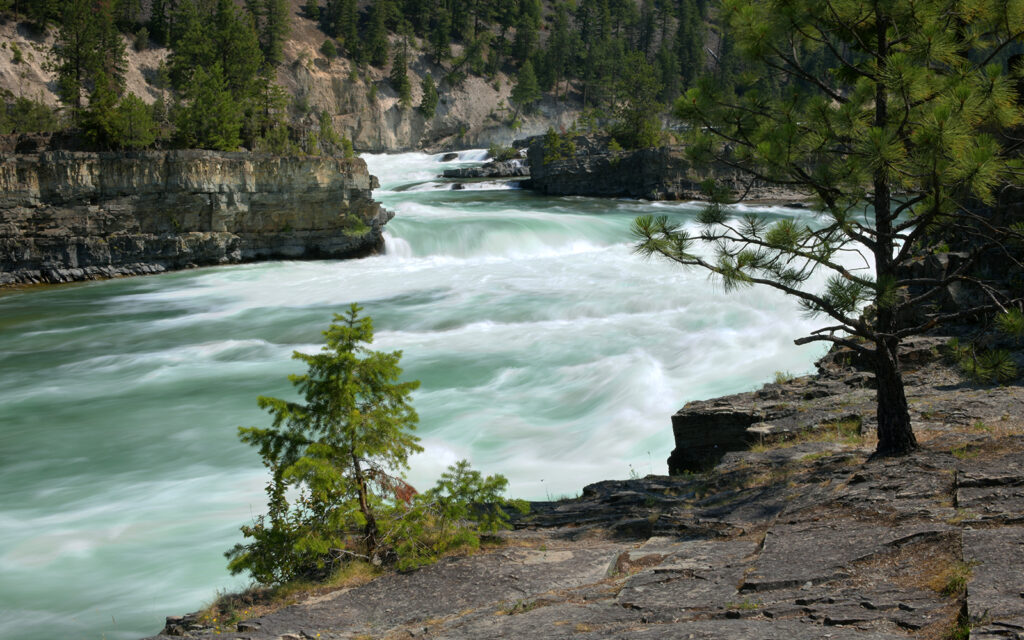

The Swinging Bridge is suspended 100 feet above and 200 feet across the Kootenai River.
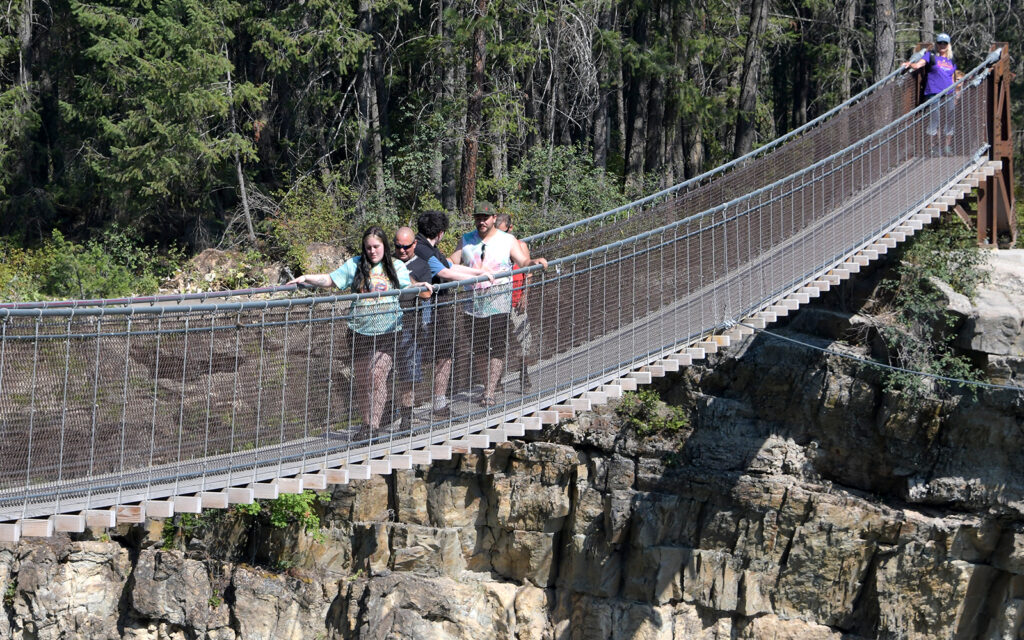
The Swinging Bridge allows hardy souls to cross the river and, YES, I was one of them.
Well, it was now mid-July and time to move to Montana but a couple of days before leaving, two campers drowned in the river near my campsite. A husband and wife were here for a fishing weekend with another couple. The husband lost his footing and fell into the fast-moving river. His hip waders filled with water, pulling him under. His wife tried to save him and suffered the same fate. Their bodies were pulled from the water a hundred yards down river.
This event left me rattled for several days; not just because it was horrible accident but because I had seen these folks just the day before. I had just come down that harrowing driveway and made the final turn into the campground when I noticed new campers in an area where none had been before. I made eye contact with a man who looked like my “boyfriend” Mark as he was staring at “Big Ass Truck” because that’s what men do—they drool over my hot wheels. I couldn’t believe that less than 24 hours later, he and his wife were dead.
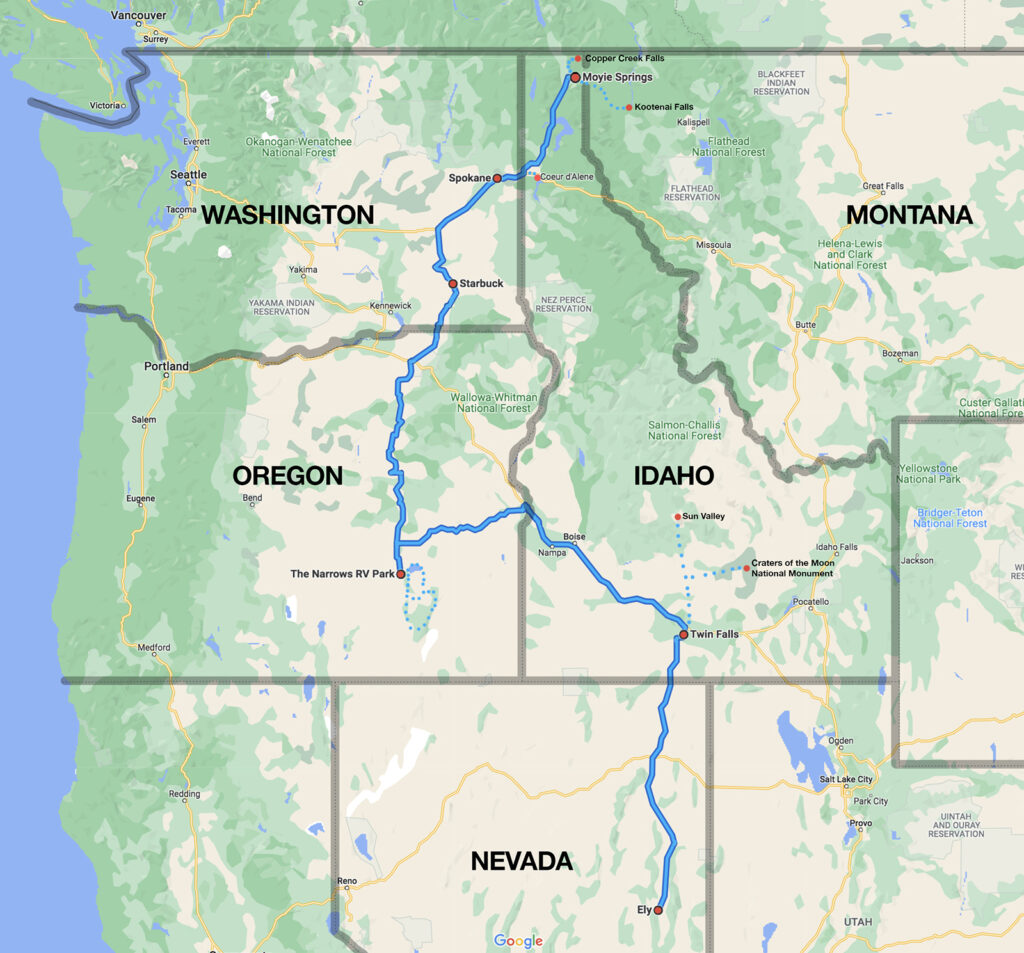
My 1,115-mile route from Nevada to Idaho, Oregon, Washington, and back to Idaho.
Next post: Western Montana.
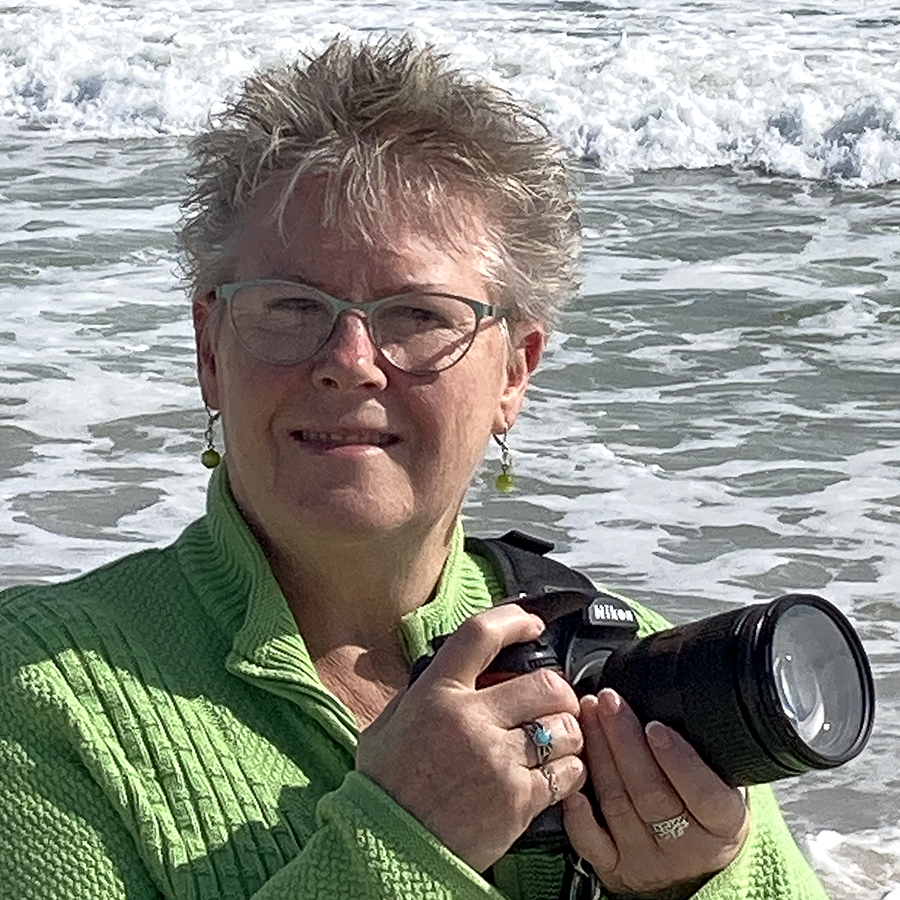
My name is Lindsay Reed. I’m a photographer and retired graphic artist with a passion for both lighthouses and road trips. I lived as a full-time solo RVer in my 33-foot Grand Design Reflection fifth-wheel trailer for over four years, traveling the U.S. and Canada photographing not only lighthouses but everything else there is to see in this wonderful land. I hope you enjoy my blog and the many adventures from my life on the road.